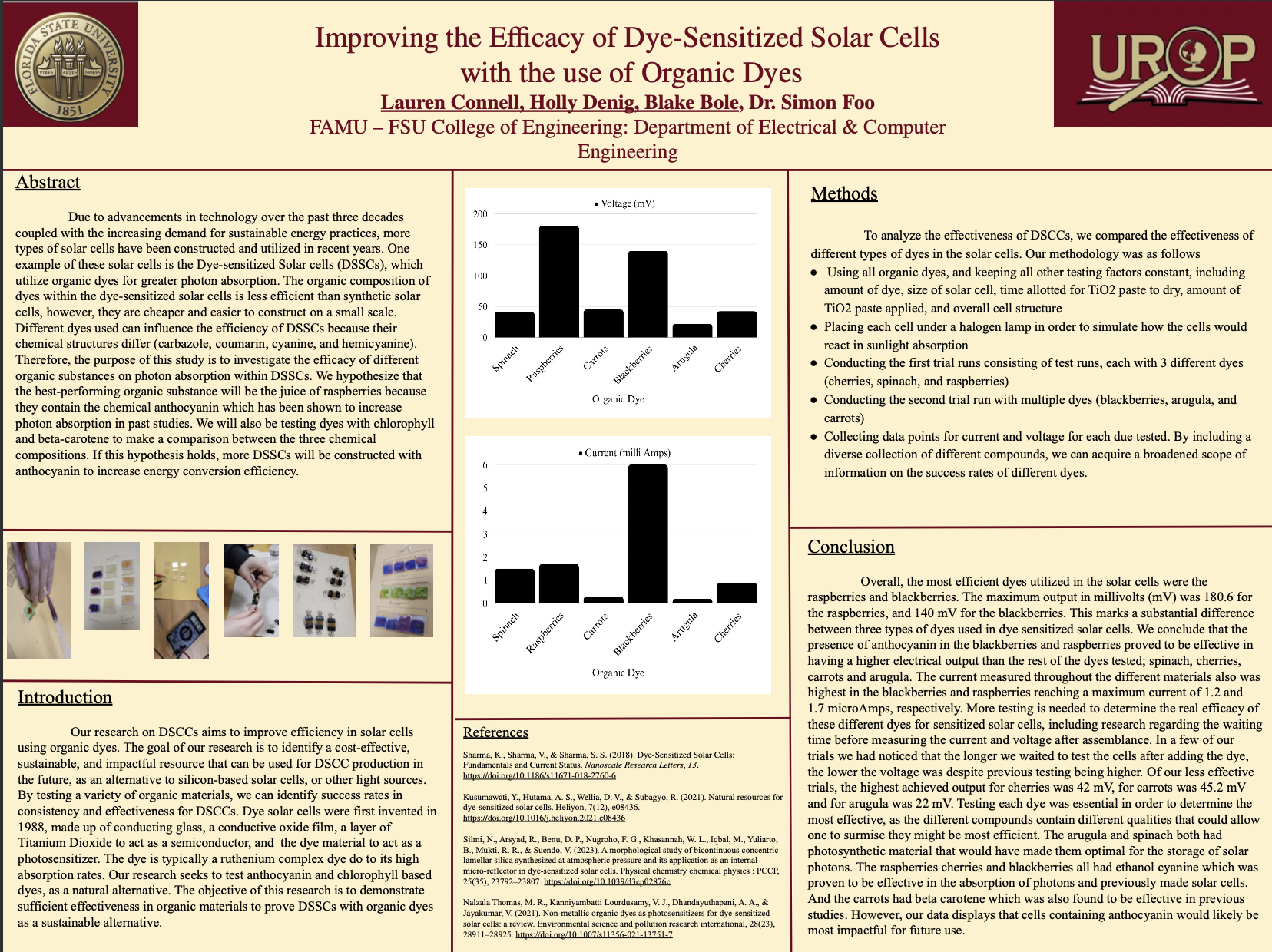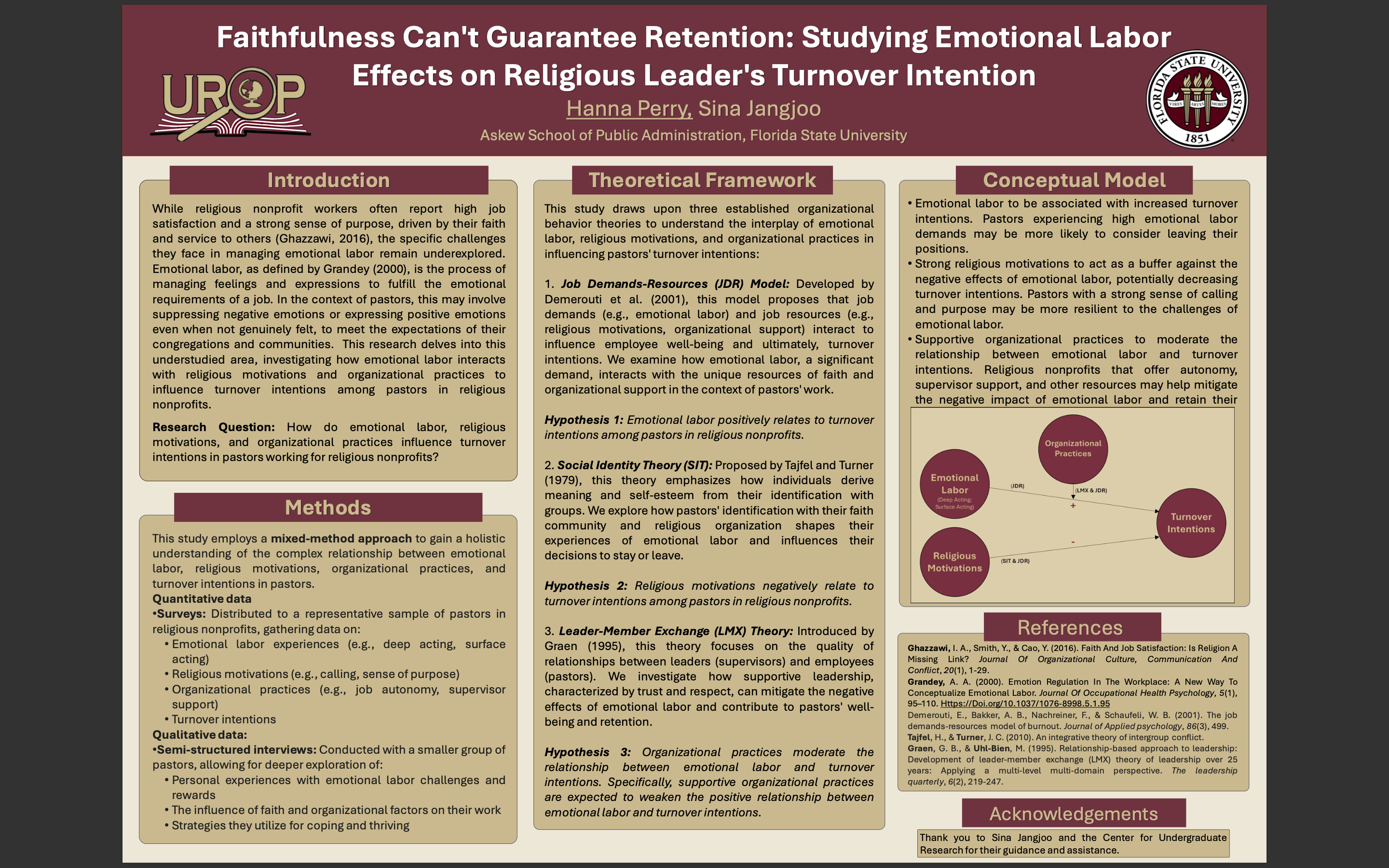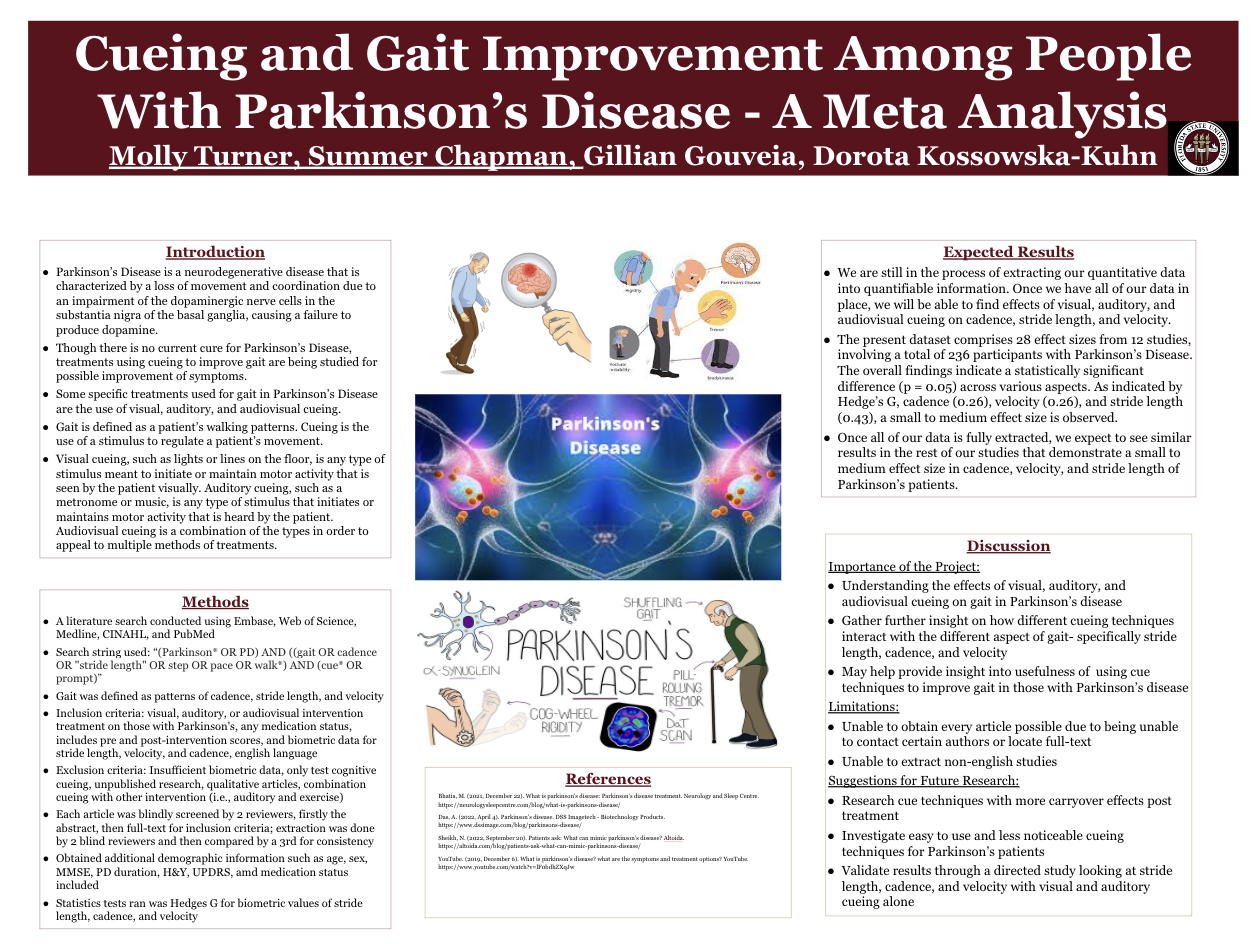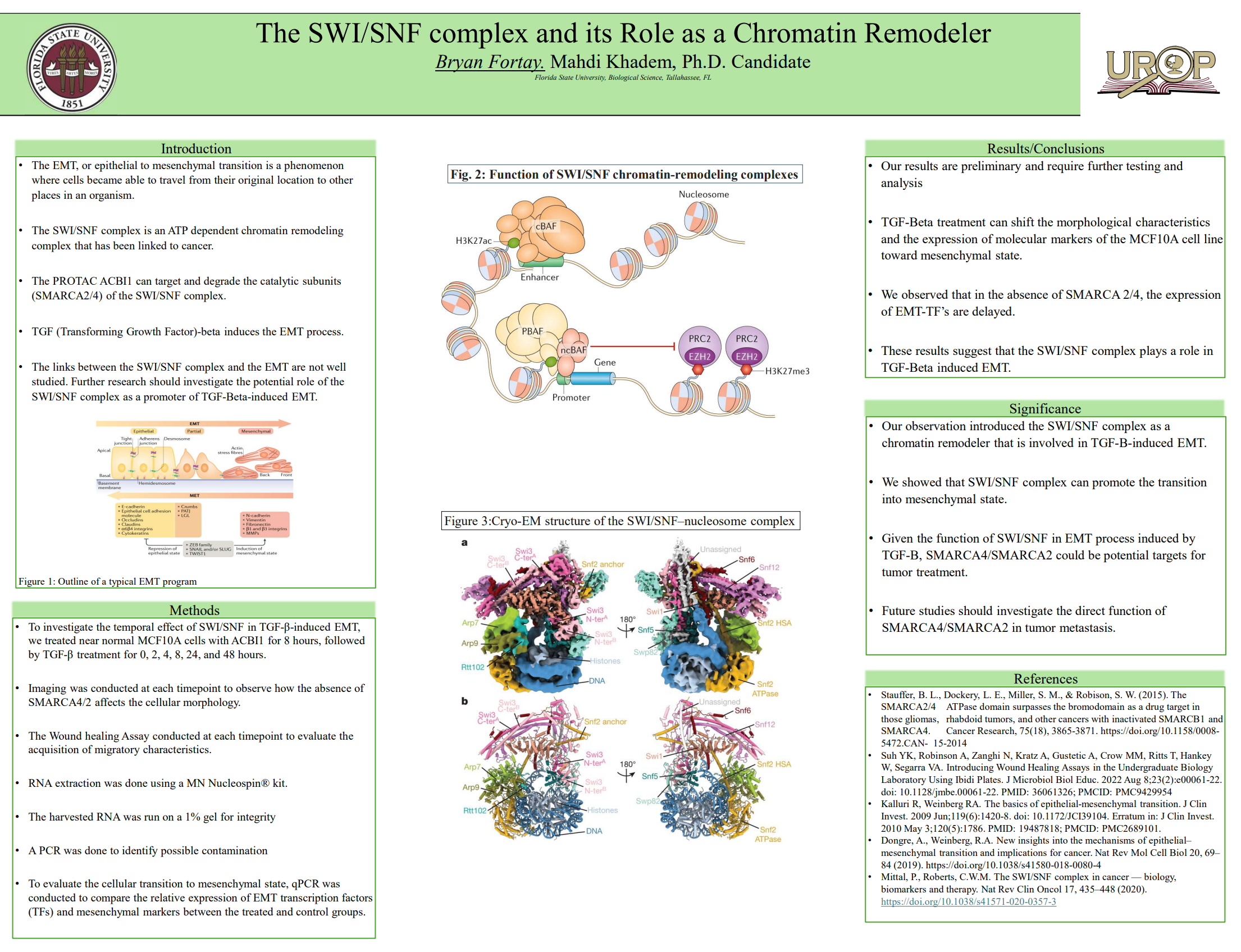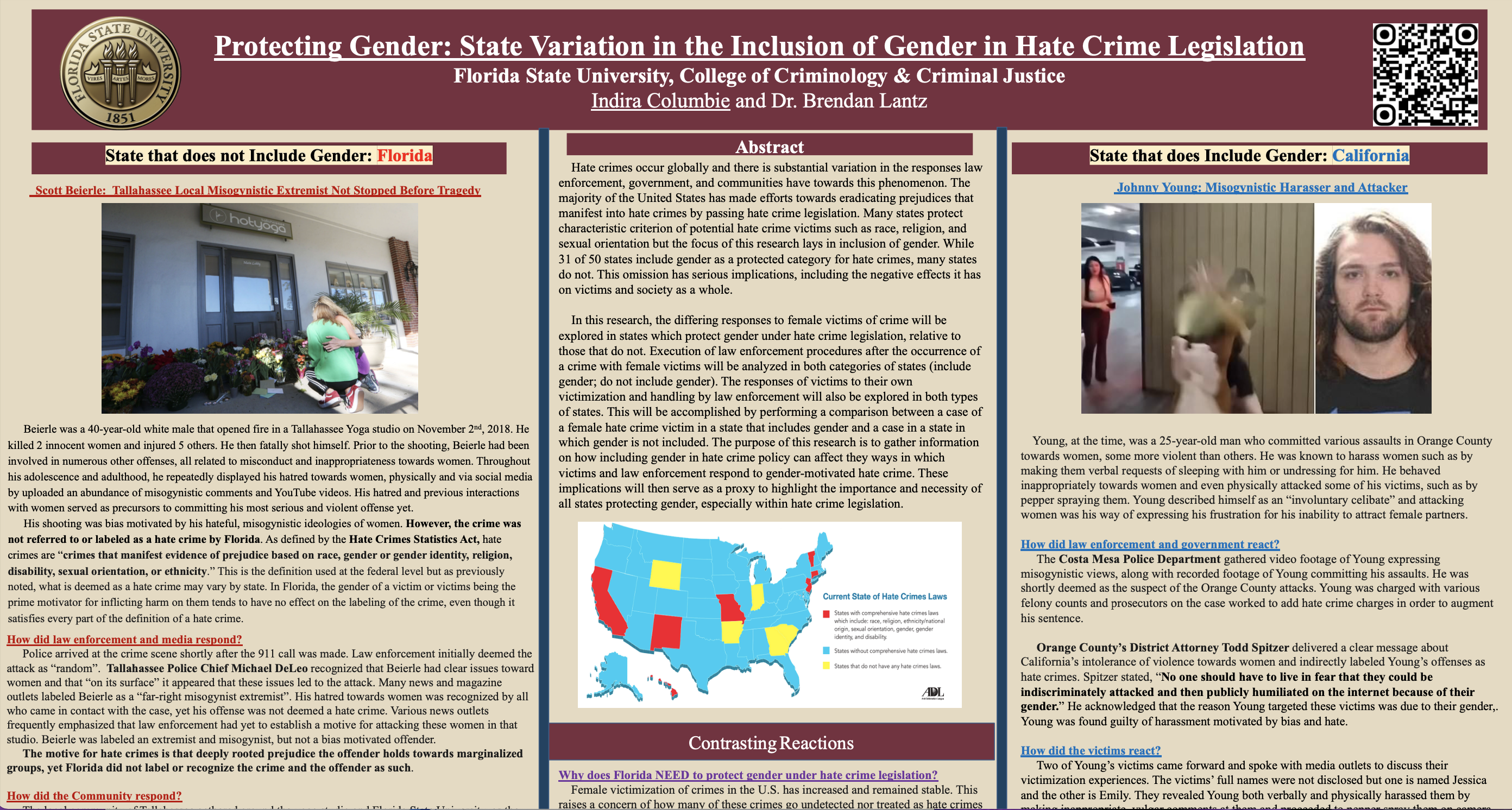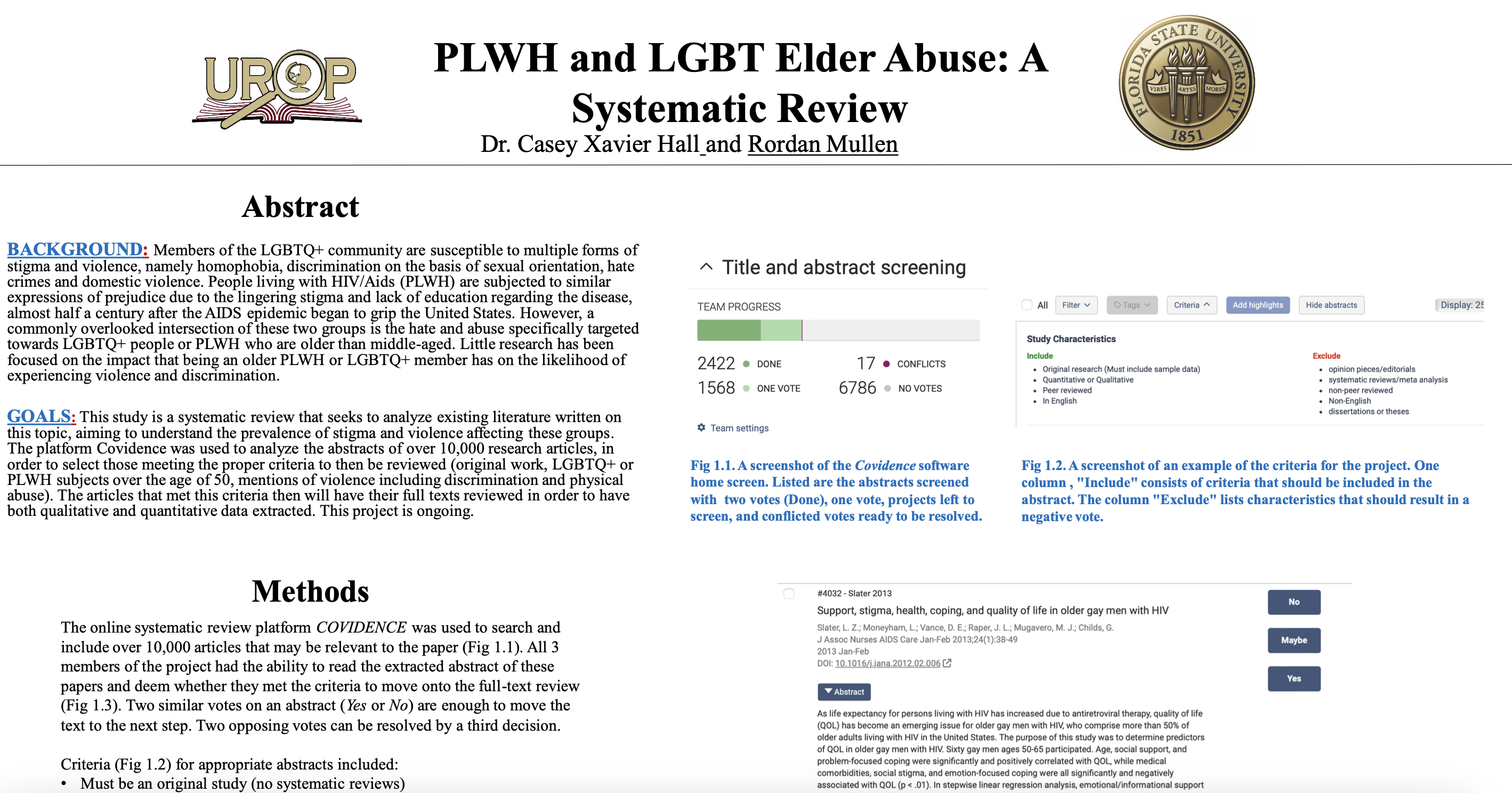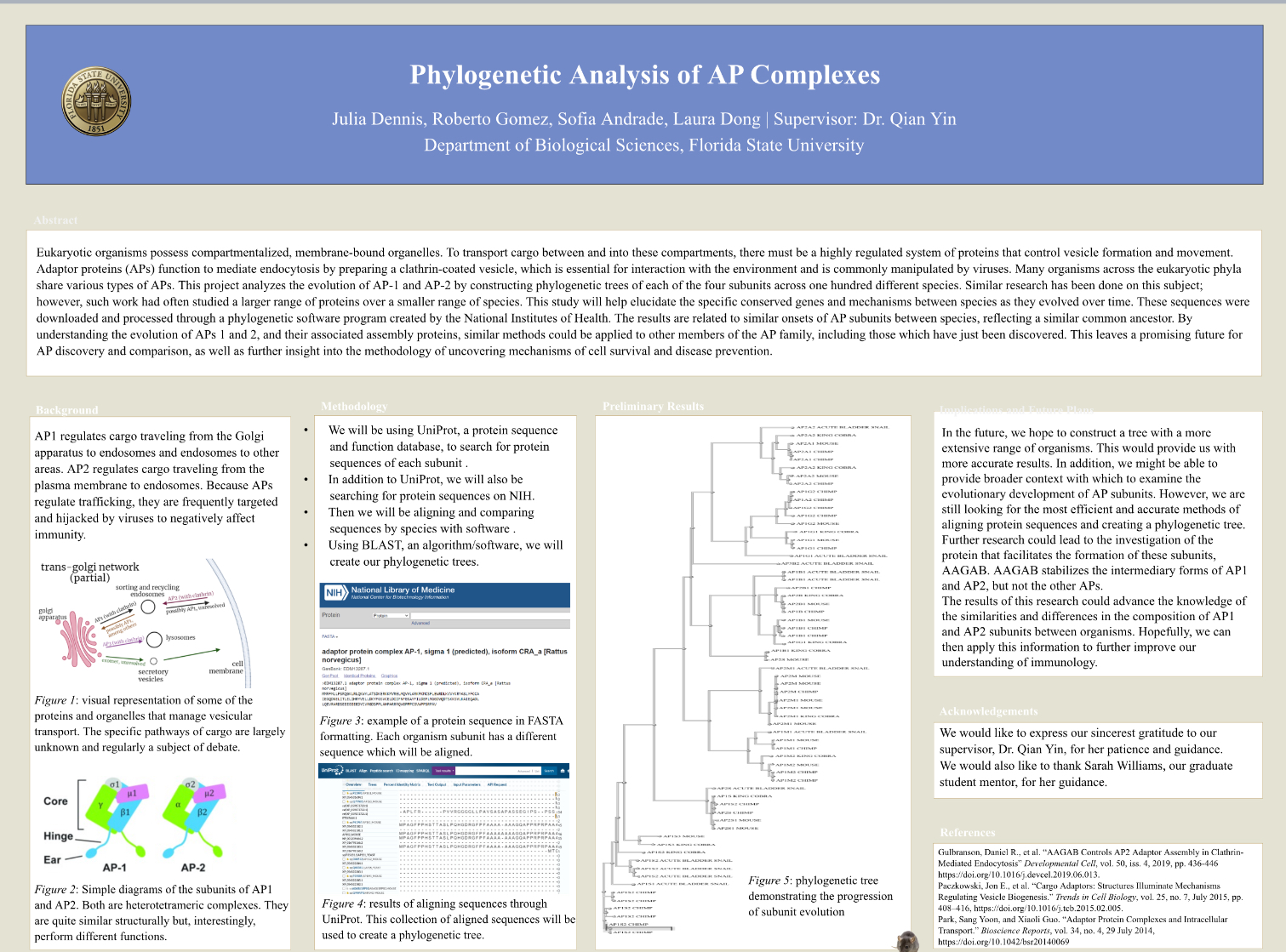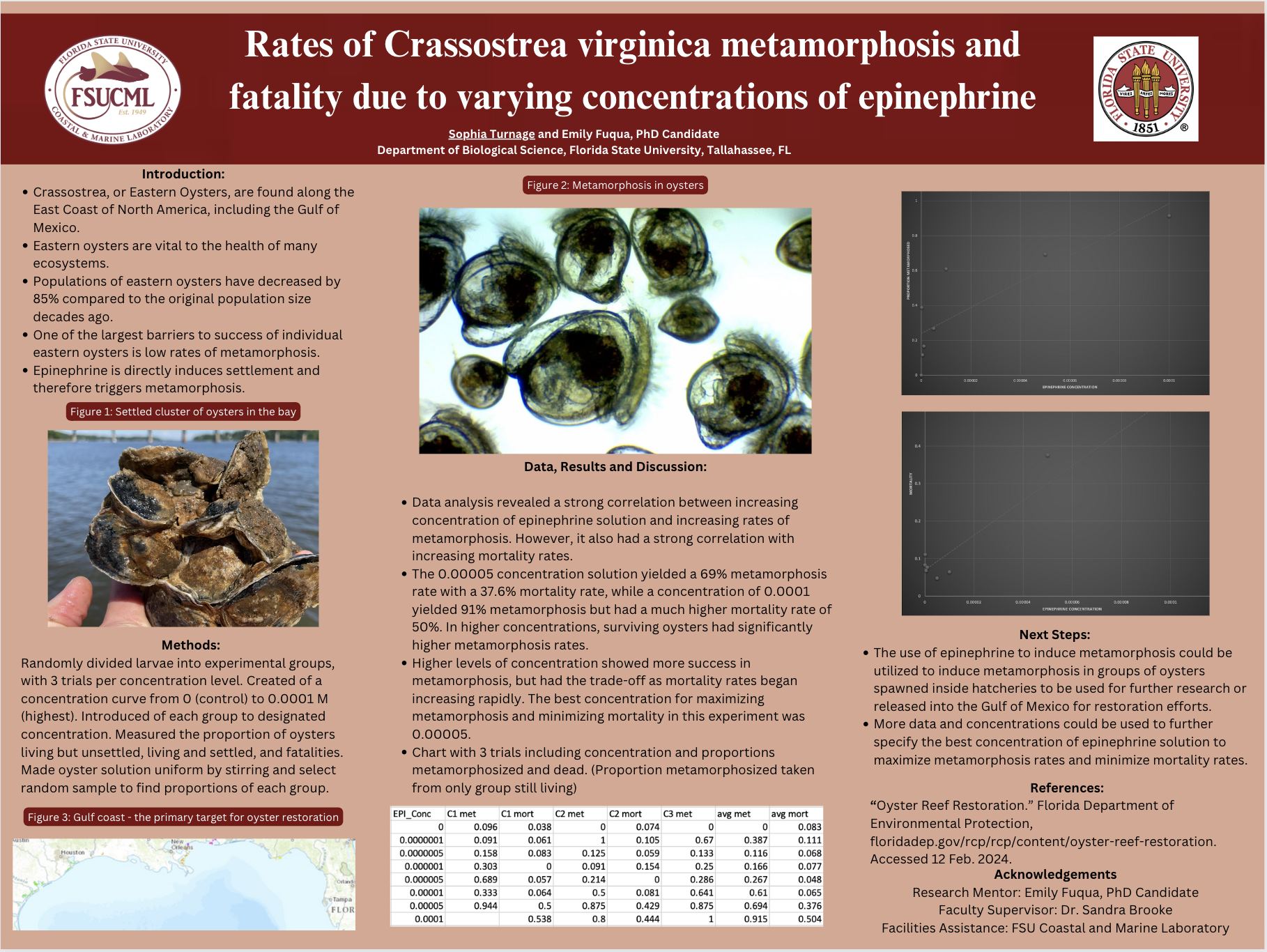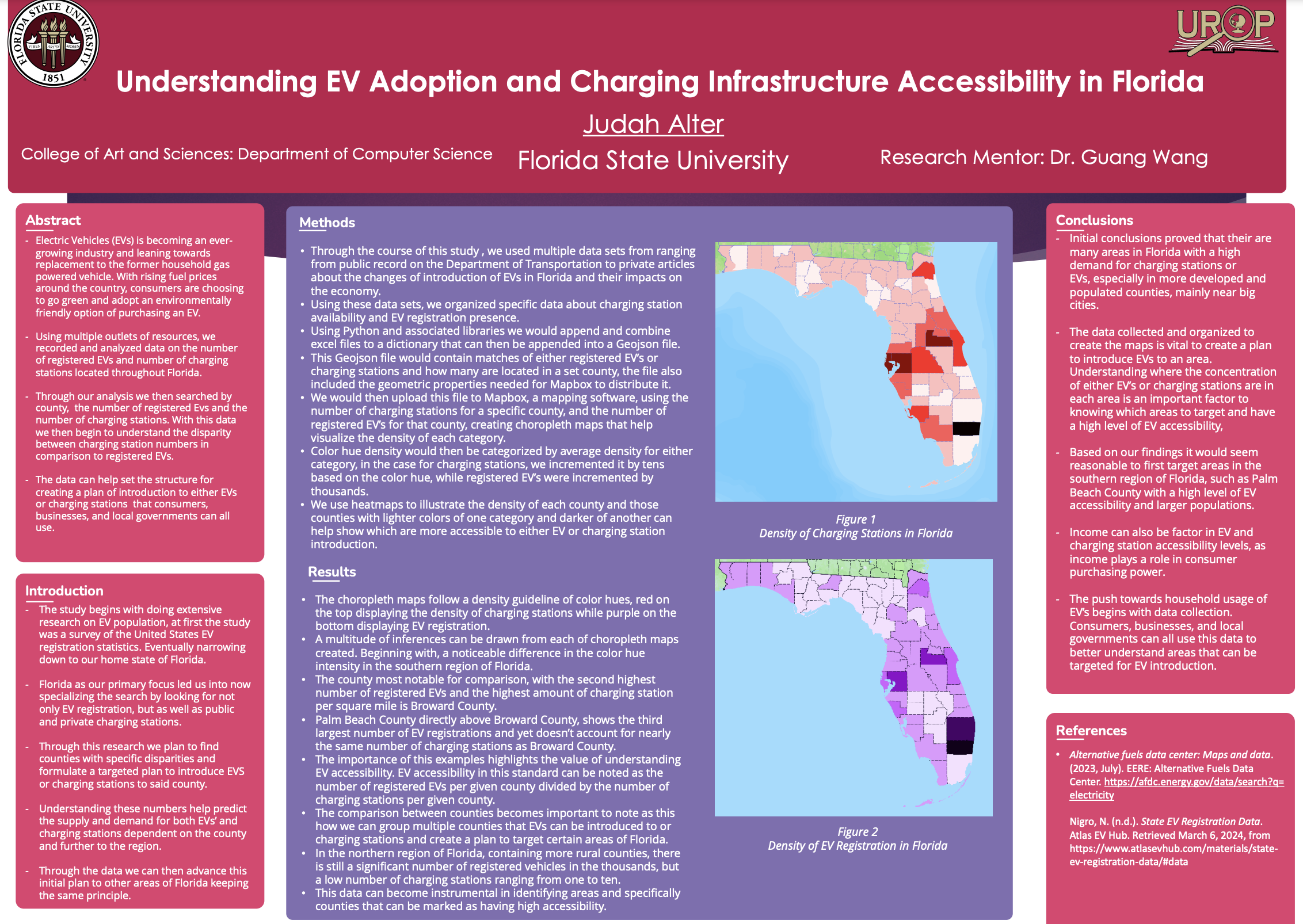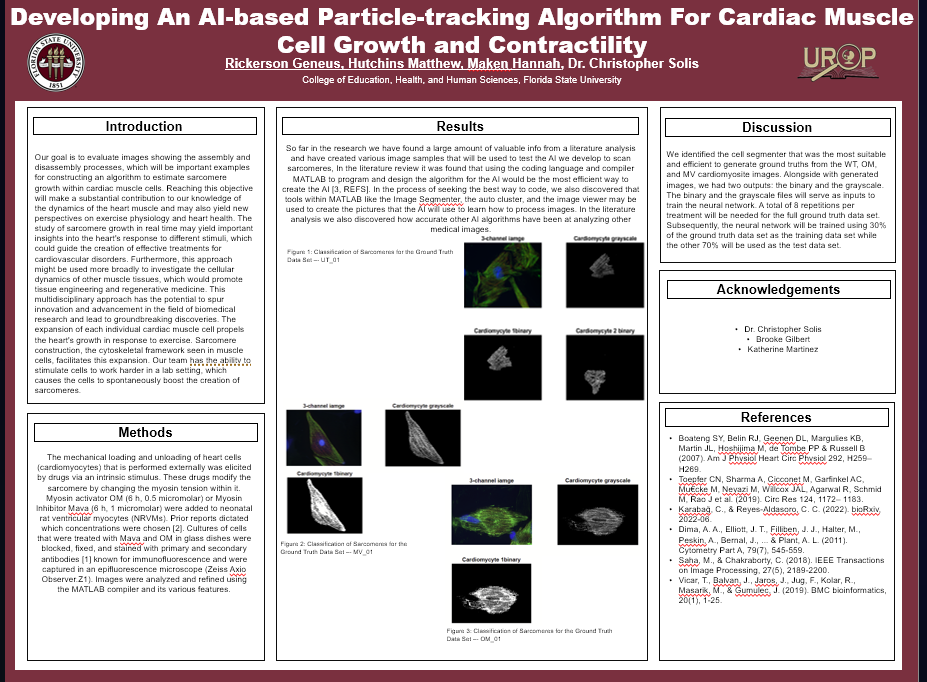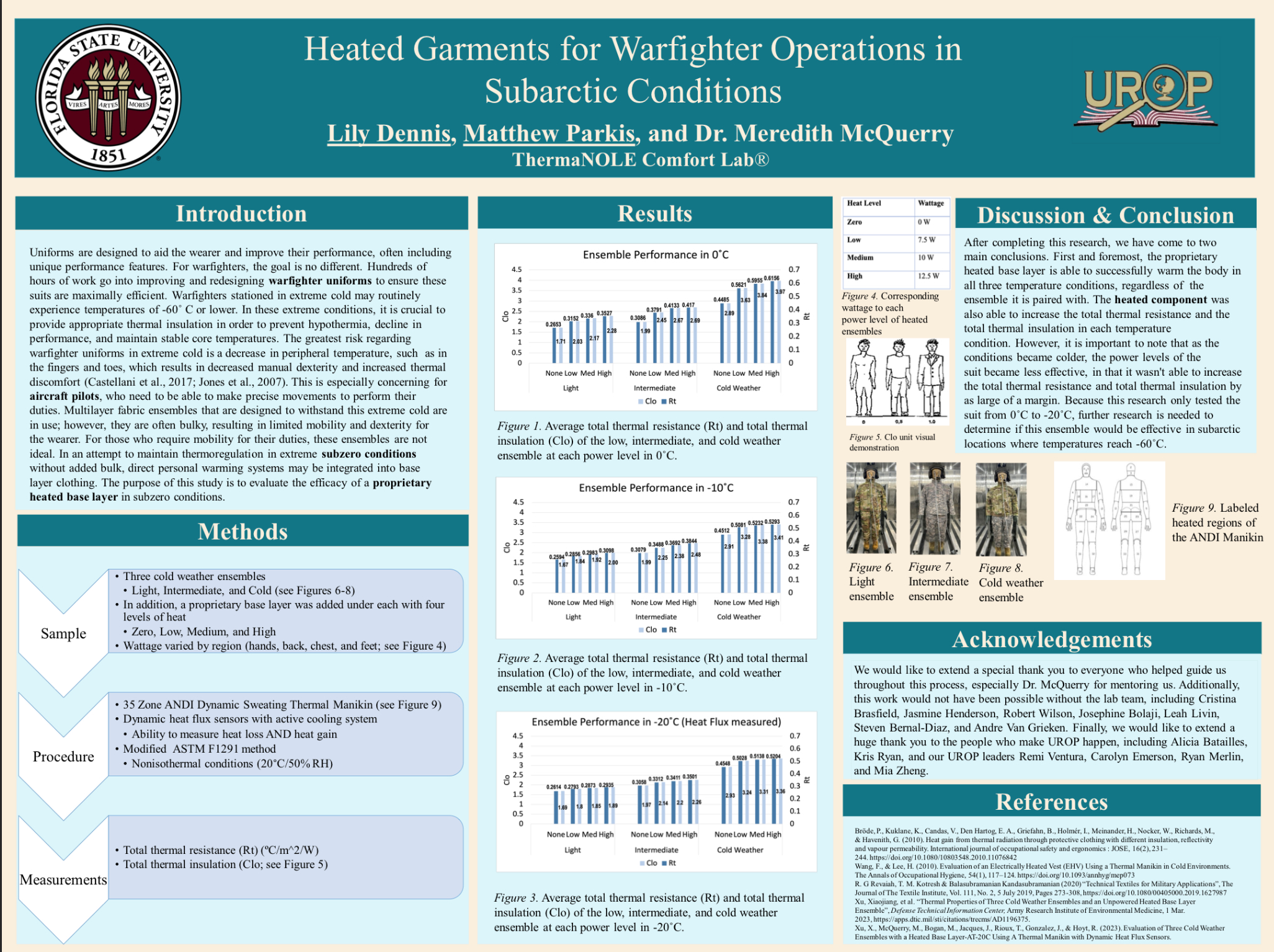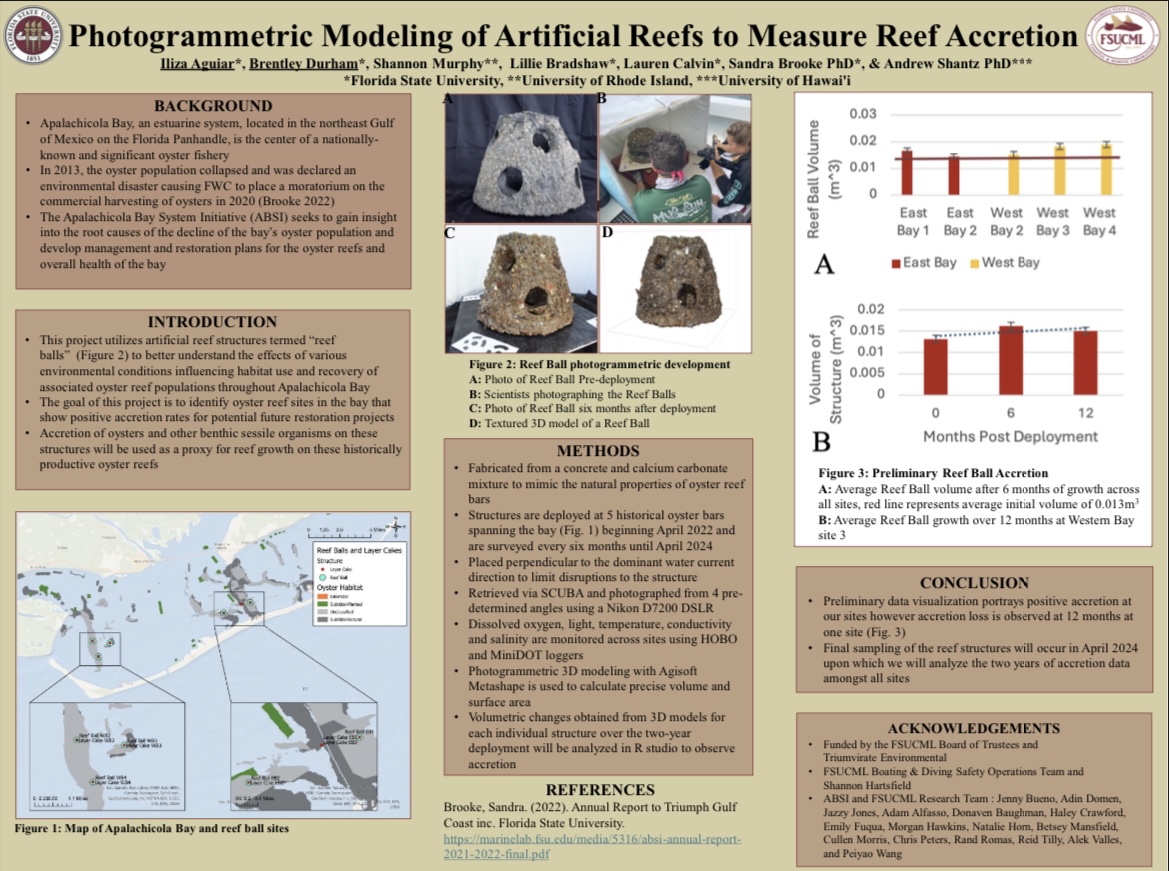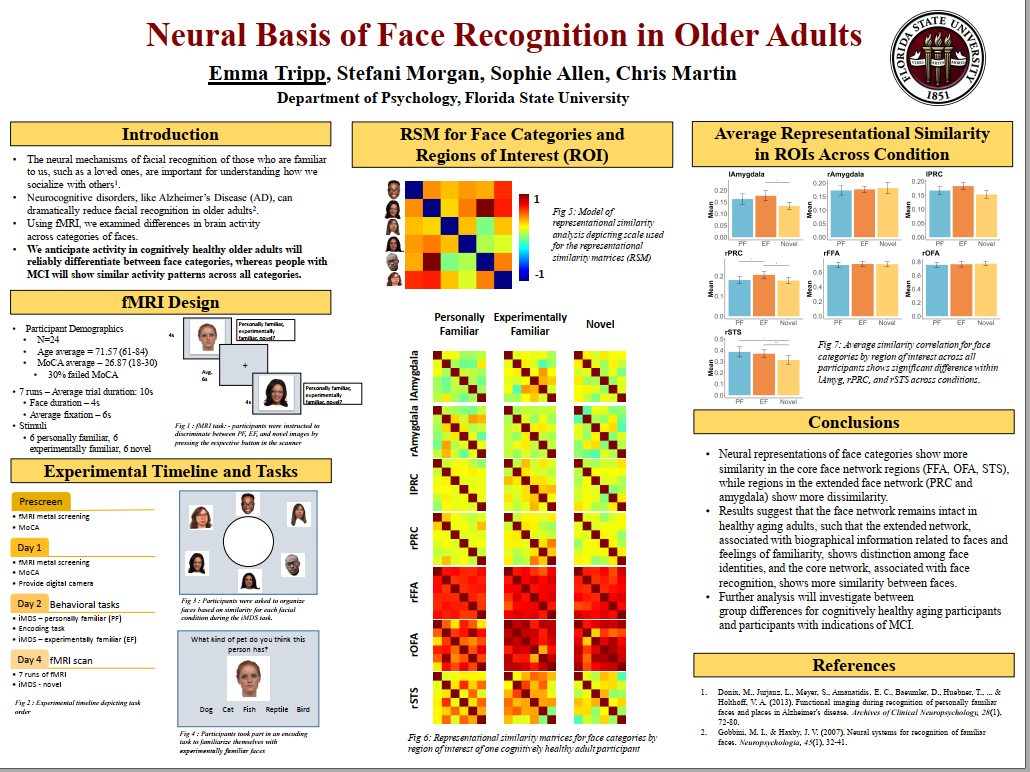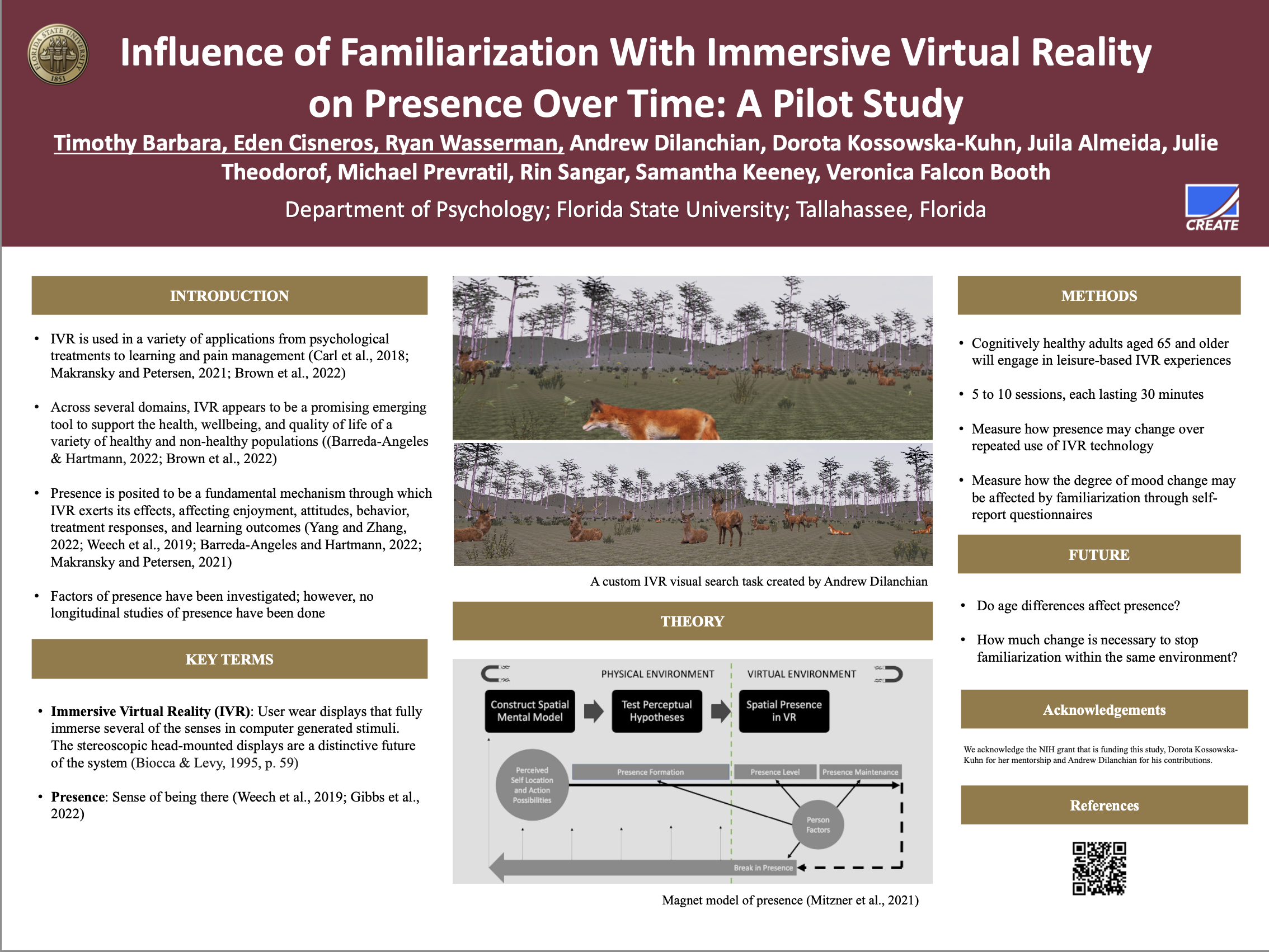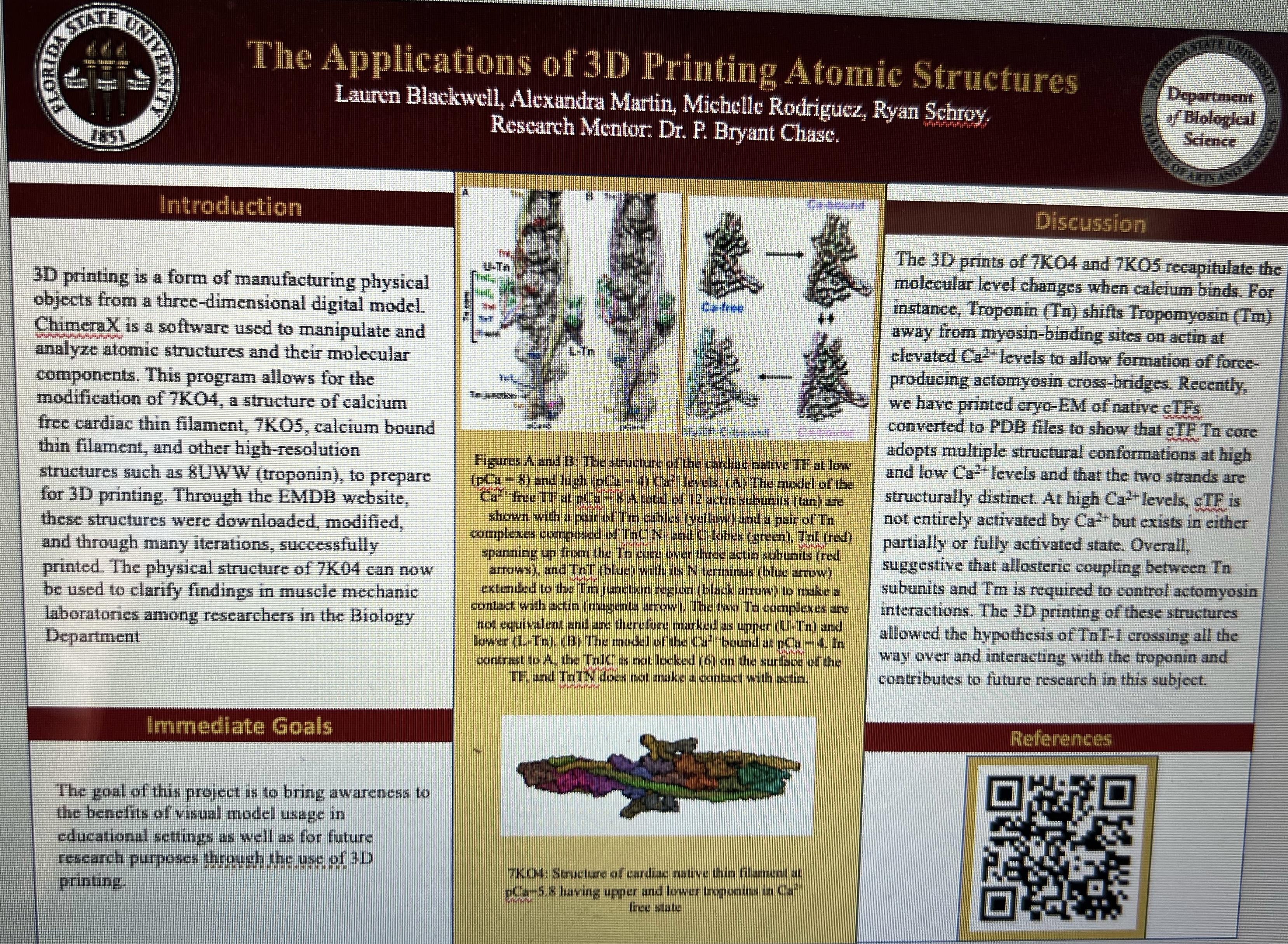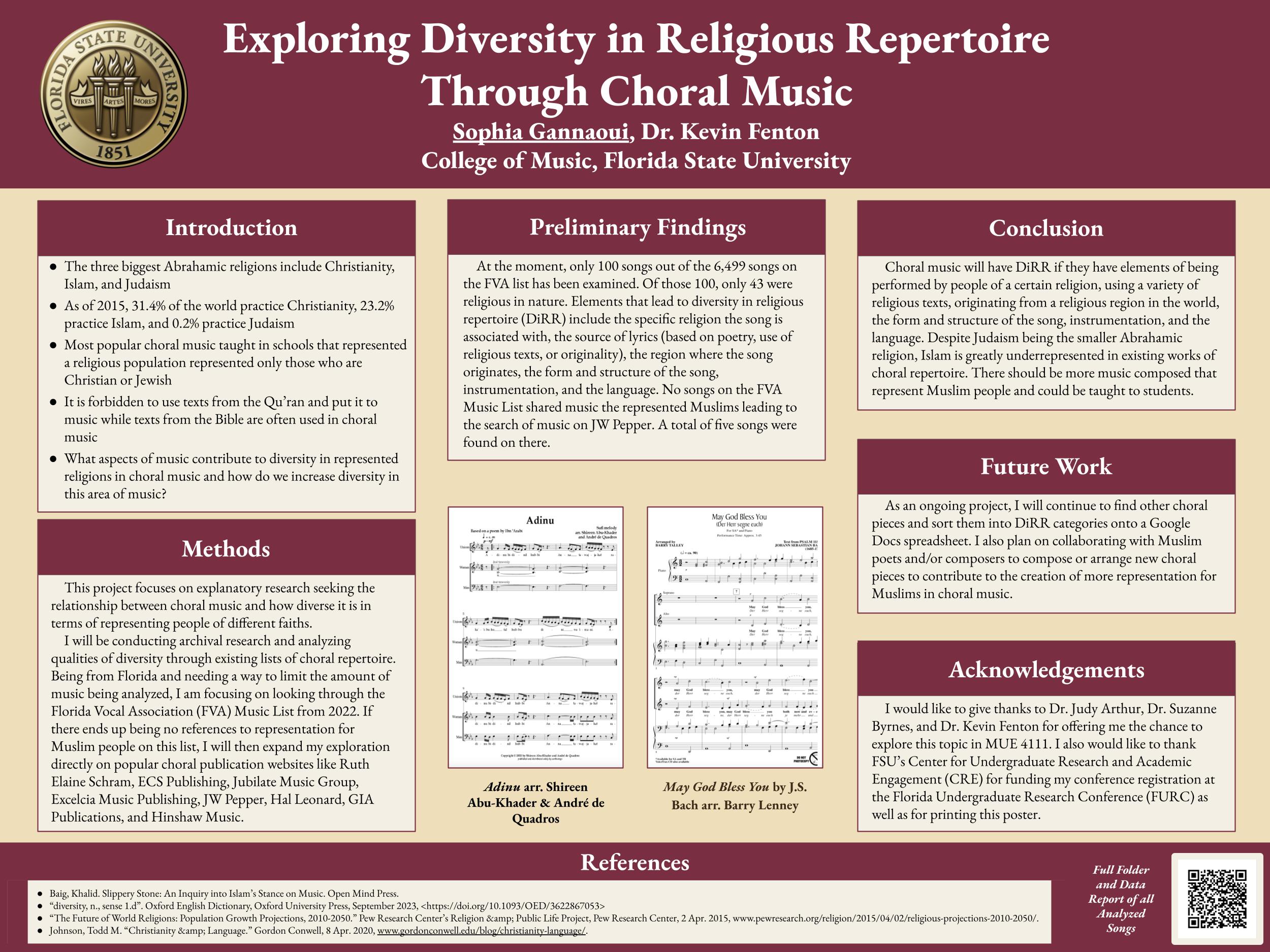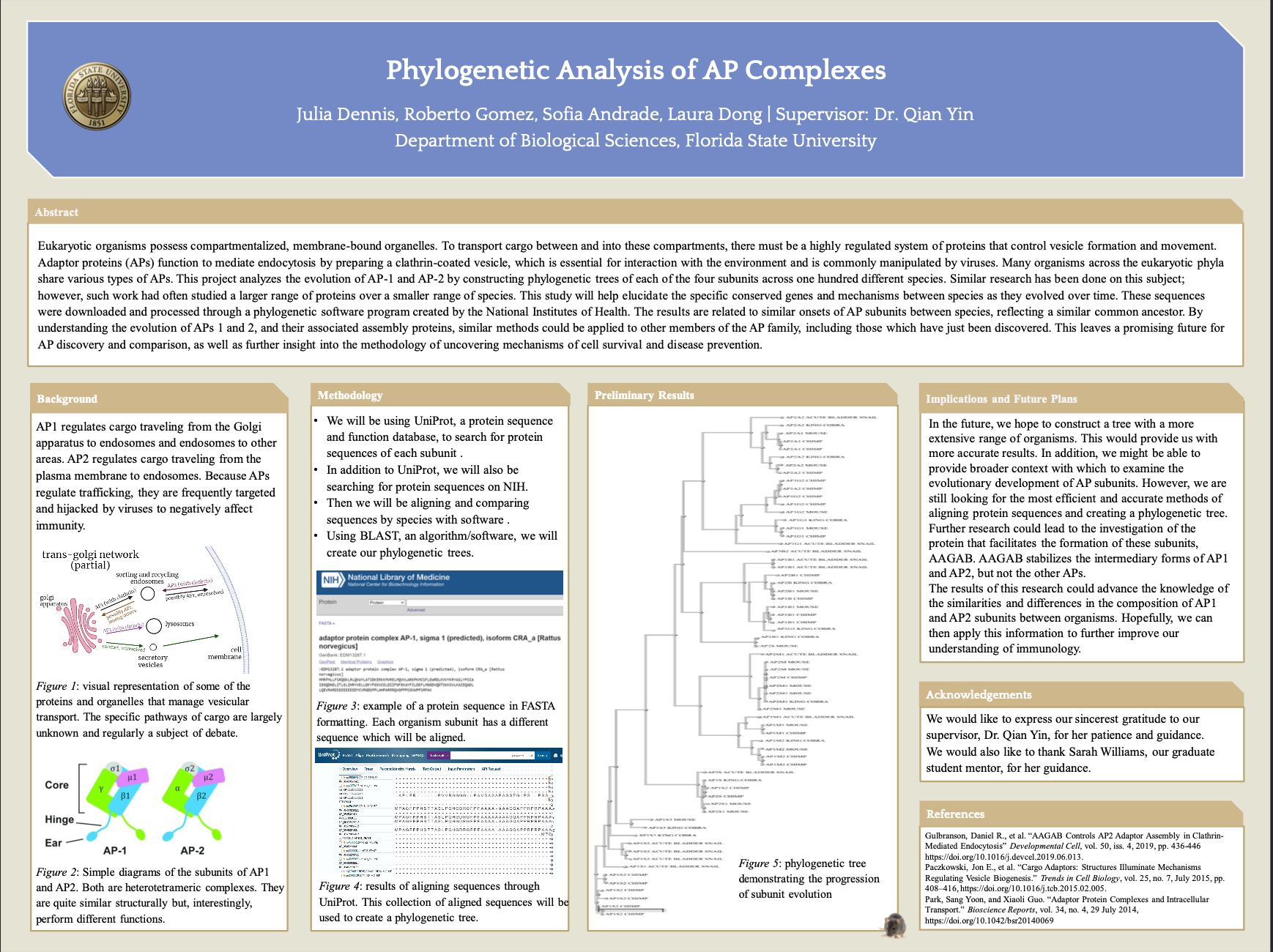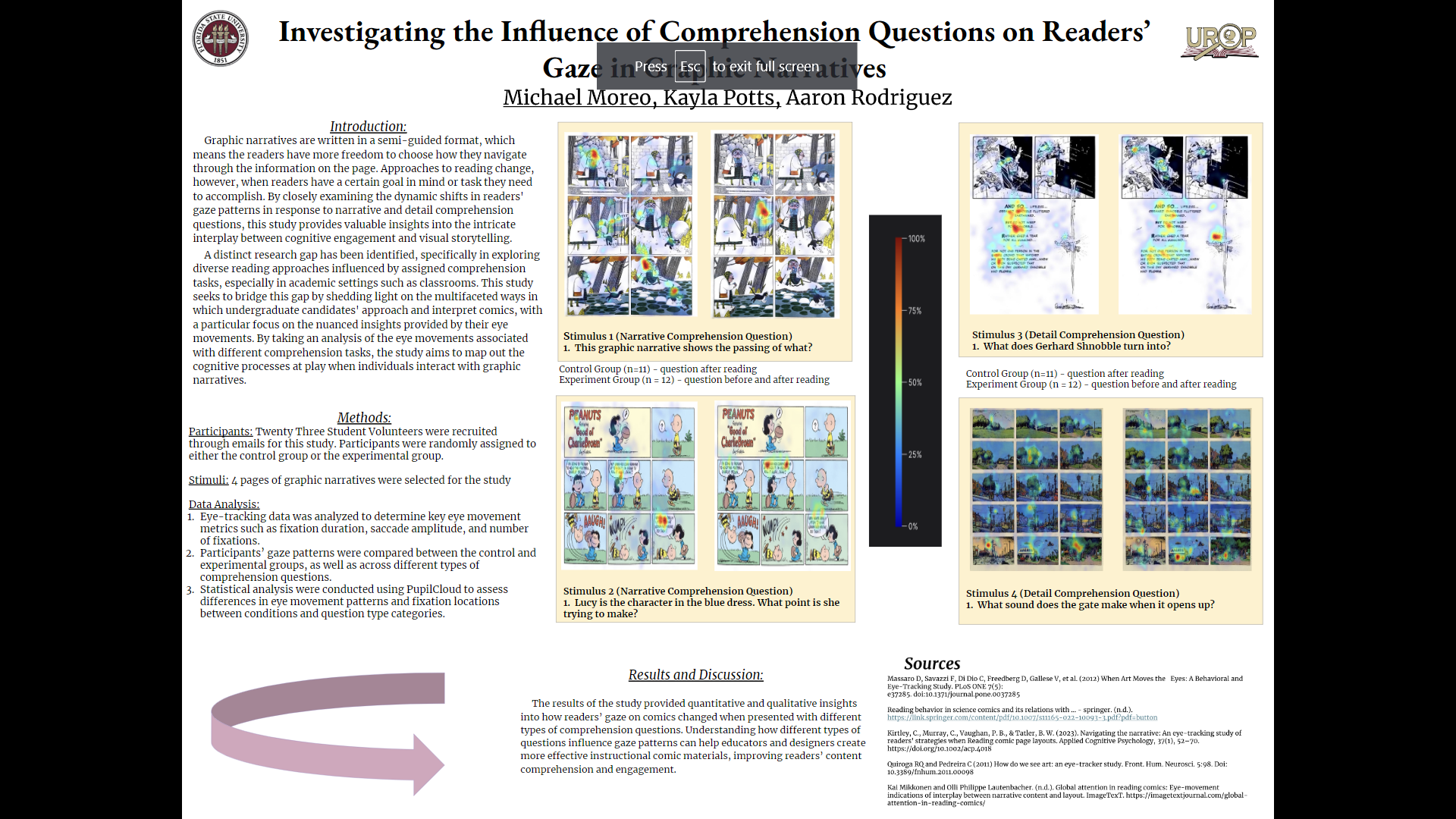Research Symposium
24th annual Undergraduate Research Symposium, April 3, 2024
Lauren Connell Poster Session 4: 2:45 pm - 3:45 pm /336
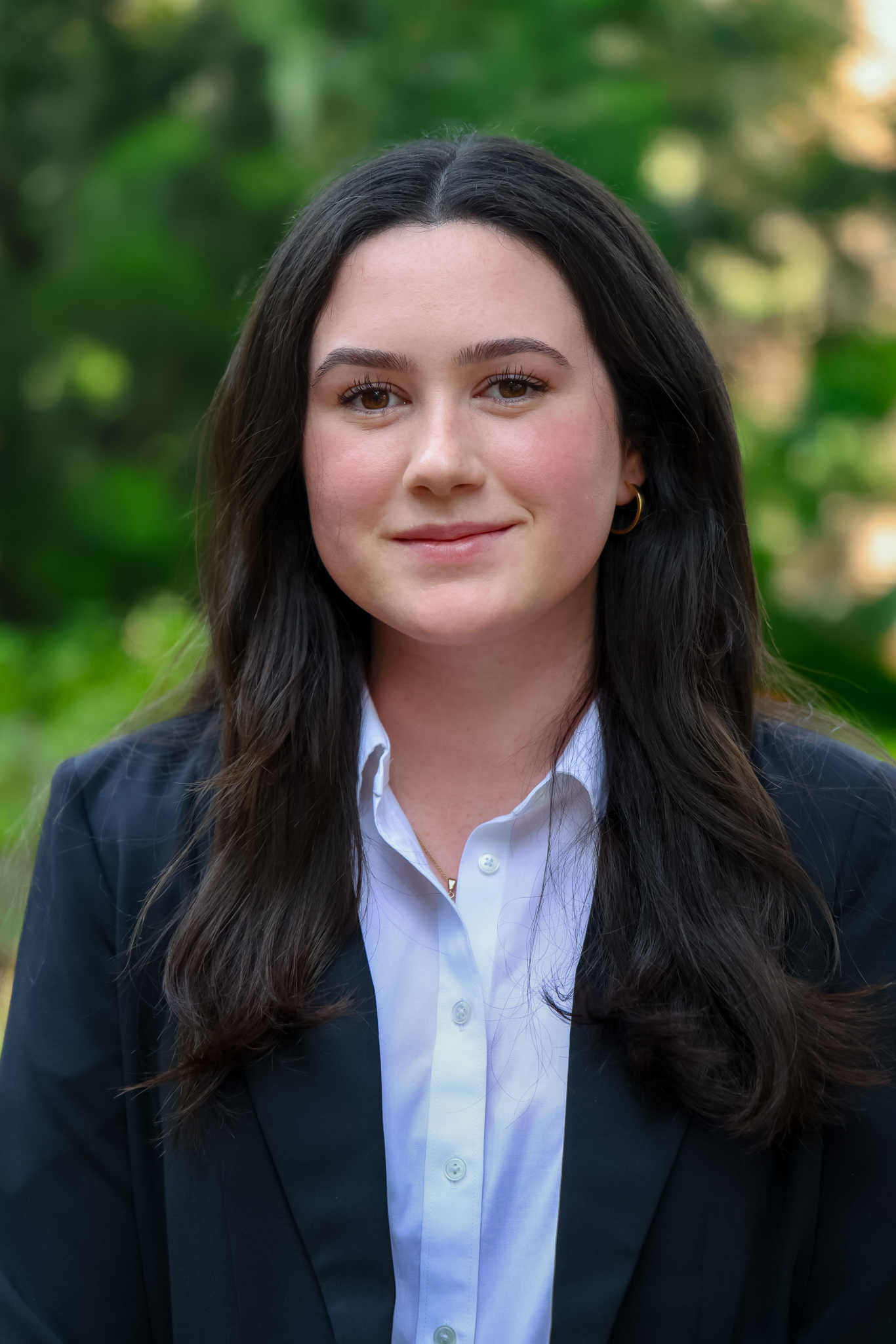
BIO
My name is Lauren Connell and I am a Sophomore IMS major from Naples, Florida. I hope to become a physician in the future and this goal is propelled by my love for science and math. I wanted to be a part of this UROP project because it allowed me to explore my interests in environmentally sustainable engineering, chemistry, and physics! I am part of the FSU Honors program, and the Honors Medical Scholars program at FSU, where I serve as the service chair for the organization. I am also an active member of several student clubs and organizations such as the being a senator on the FSU student senate, a race team member of the FSU sailing team, and a member of the Phi Delta Epsilon pre-medical fraternity.
Improving the Efficacy of Dye-Sensitized Solar Cells with the use of Organic Dyes
Authors: Lauren Connell, Simon FooStudent Major: IMS: Clinical Professions
Mentor: Simon Foo
Mentor's Department: Electrical and Computer Engineering Mentor's College: FAMU FSU College of Engineering Co-Presenters: Blake Bole, Holly Denig
Abstract
Due to advancements in technology over the past three decades coupled with the increasing demand for sustainable energy practices, more types of solar cells have been constructed and utilized in recent years. One example of these solar cells is the Dye-sensitized Solar cells (DSSCs), which utilize organic dyes for greater photon absorption. The organic composition of dyes within the dye-sensitized solar cells is less efficient than synthetic solar cells, however, they are cheaper and easier to construct on a small scale. Different dyes used can influence the efficiency of DSSCs because their chemical structures differ (carbazole, coumarin, cyanine, and hemicyanine). Therefore, the purpose of this study is to investigate the efficacy of different organic substances on photon absorption within DSSCs. We hypothesize that the best-performing organic substance will be the juice of raspberries because they contain the chemical anthocyanin which has been shown to increase photon absorption in past studies. We will also be testing dyes with chlorophyll and beta-carotene to make a comparison between the three chemical compositions. If this hypothesis holds, more DSSCs will be constructed with anthocyanin to increase energy conversion efficiency.
Keywords: Sustainability, Solar Cells, Renewable Energy, Environmental Engineering, Electrical Engineering
24th annual Undergraduate Research Symposium, April 3, 2024
Vivian Gobler Poster Session 5: 4:00 pm - 5:00 pm/270
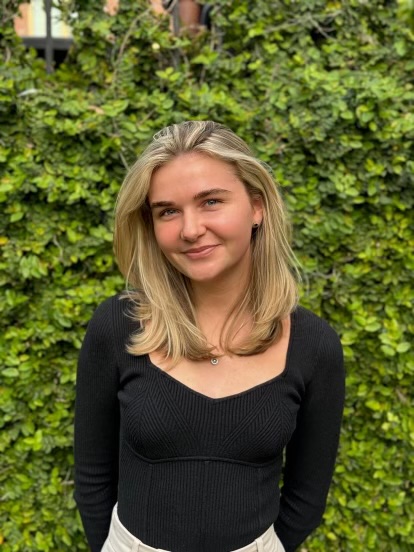
BIO
Being apart of Dr. Shore’s research lab has been an educational and growing experience within school and personal life. Going into this project I was aware research and education on substance misuse interested me but was unaware of the support systems that can be included in recovery such as Collegiate Recovery Programs. I hope to participate in more research similar to Dr. Shore’s through my undergraduate career and carry that knowledge over into a master’s program to pursue a career in mental health counseling.
Descriptive Database for the Field of Collegiate Recovery Programs
Authors: Vivian Gobler, Chelsea ShoreStudent Major: Psychology
Mentor: Chelsea Shore
Mentor's Department: Collegiate Recovery Program Research Lab Mentor's College: Association of Recovery in Higher Education Co-Presenters: Zane Reese, Sydney Mock, Daniel Jordan, Roxie Richbourg, Anne Marquardt
Abstract
In a scoping literature review conducted by N. Vest et al. (2021), a significant gap was identified in available evidence regarding Collegiate Recovery Programs (CRPs). Despite conducting a thorough search up to August 2020, only 54 articles meeting stringent criteria were found. To address this deficiency and build upon the work of Vest et al., Dr. Shore, with support from the Association of Recovery in Higher Education (ARHE), established an online descriptive database. This database was specifically designed to aid college recovery program providers and collegiate administrators. It contains over 100 meticulously analyzed articles related to CRPs and college student recovery from substance use and misuse. The articles are systematically categorized by various criteria such as author, journal, year, title, methodology, analyses, key findings, substance use disorder and behavioral health topics, theories, and integrated behavioral health areas. This comprehensive and structured resource aims to serve as a valuable tool for advancing research in the field of collegiate recovery. The ultimate goal of the database is to provide guidance to practitioners in the collegiate recovery field, thereby facilitating the development and enhancement of CRPs within higher education institutions (HEIs).
Keywords: Collegiate Recovery, Database, Substance Misuse
24th annual Undergraduate Research Symposium, April 3, 2024
Noah Peacock Poster Session 4: 2:45 pm - 3:45 pm/4

BIO
My name is Noah Peacock and I am an undergraduate researcher and AAUS Scientific diver with the FSUCML Academic Dive Program. I have had the pleasure of working alongside Allie Blanchette as a UROP student focusing on damselfish behavior, as well as Mariana Fuentes for vessel strike surveys on the analysis of sea turtle foraging behaviors. My passion for research and behavioral ecology has led me to become an established member of the FSU Coastal Marine Lab. I look forward to pursuing a career in marine conservation and furthering my skillsets within the field of marine research.
Comparing threespot damselfish behavior on coral types Acropora cervicornis and Orbicella spp.
Authors: Noah Peacock, Allie BlanchetteStudent Major: Biological Sciences
Mentor: Allie Blanchette
Mentor's Department: Biological Sciences Mentor's College: College of Arts and Sciences Co-Presenters: Sofia Lara
Abstract
Farmer damselfish (family: Pomacentridae) are a functional group of territorial herbivorous coral reef fish. They create algae farms by chasing away other herbivores and biting at live coral tissue to expand their territories. Damselfish can vary in how aggressively they defend their territories based on habitat quality. In the Caribbean, the endangered branching coral Acropora cervicornis is considered the preferred habitat for the threespot damselfish Stegastes planifrons. Our objective was to determine if threespot damselfish exhibit different farming behaviors on A. cervicornis versus a common non-branching coral Orbicella spp. To do this, a group of 2-3 divers placed cameras 1m away from damselfish territories across 9 sites in Bonaire, Caribbean Netherlands. These cameras recorded 30 minute videos that were then annotated on the behavioral observation software Boris. We found that there was no significant difference between coral types on either their territory maintenance behavior or their aggressive territoriality behavior. We also found that there is a positive correlation between damselfish density and both territory maintenance and chase behaviors. Damselfish are considered, by many restoration groups in the Caribbean, as stressors for the reef. Therefore we care about the relationship between damselfish and the coral because we can try to determine how their presence may affect coral such as Acropora cervicornis, a critically endangered species.
Keywords: Damselfish, Aggression, Coral
24th annual Undergraduate Research Symposium, April 3, 2024
Hanna Perry Poster Session 1: 9:30 am - 10:30 am /301

BIO
Hanna Perry is a second-year student at Florida State, pursuing a double major in English Literature and Environmental Science. Originally from Orlando, Hanna's research endeavors focus on the nexus between religious motivations and psychology, as well as delving into the organizational structures of nonprofit entities.
Faithfulness Can't Guarantee Retention: Studying Emotional Labor Effects on Religious Leader's Turnover Intention
Authors: Hanna Perry, Sina JangjooStudent Major: English Literature and Environmental Science/Policy
Mentor: Sina Jangjoo
Mentor's Department: Askew School of Public Administration and Policy Mentor's College: College of Social Sciences an Public Policy Co-Presenters:
Abstract
While religious nonprofit workers often report high job satisfaction and a strong sense of purpose, driven by their faith and service to others (Ghazzawi, 2016), the specific challenges they face in managing emotional labor remain underexplored. Emotional labor, as defined by Grandey (2000), is the process of managing feelings and expressions to fulfill the emotional requirements of a job. In the context of pastors, this may involve suppressing negative emotions or expressing positive emotions even when not genuinely felt, to meet the expectations of their congregations and communities. This research delves into this understudied area, investigating how emotional labor interacts with religious motivations and organizational practices to influence turnover intentions among pastors in religious nonprofits.
Keywords: Nonprofit, Turnover, Emotional Labor
24th annual Undergraduate Research Symposium, April 3, 2024
Summer Chapman Poster Session 2: 10:45 am - 11:45 am/354
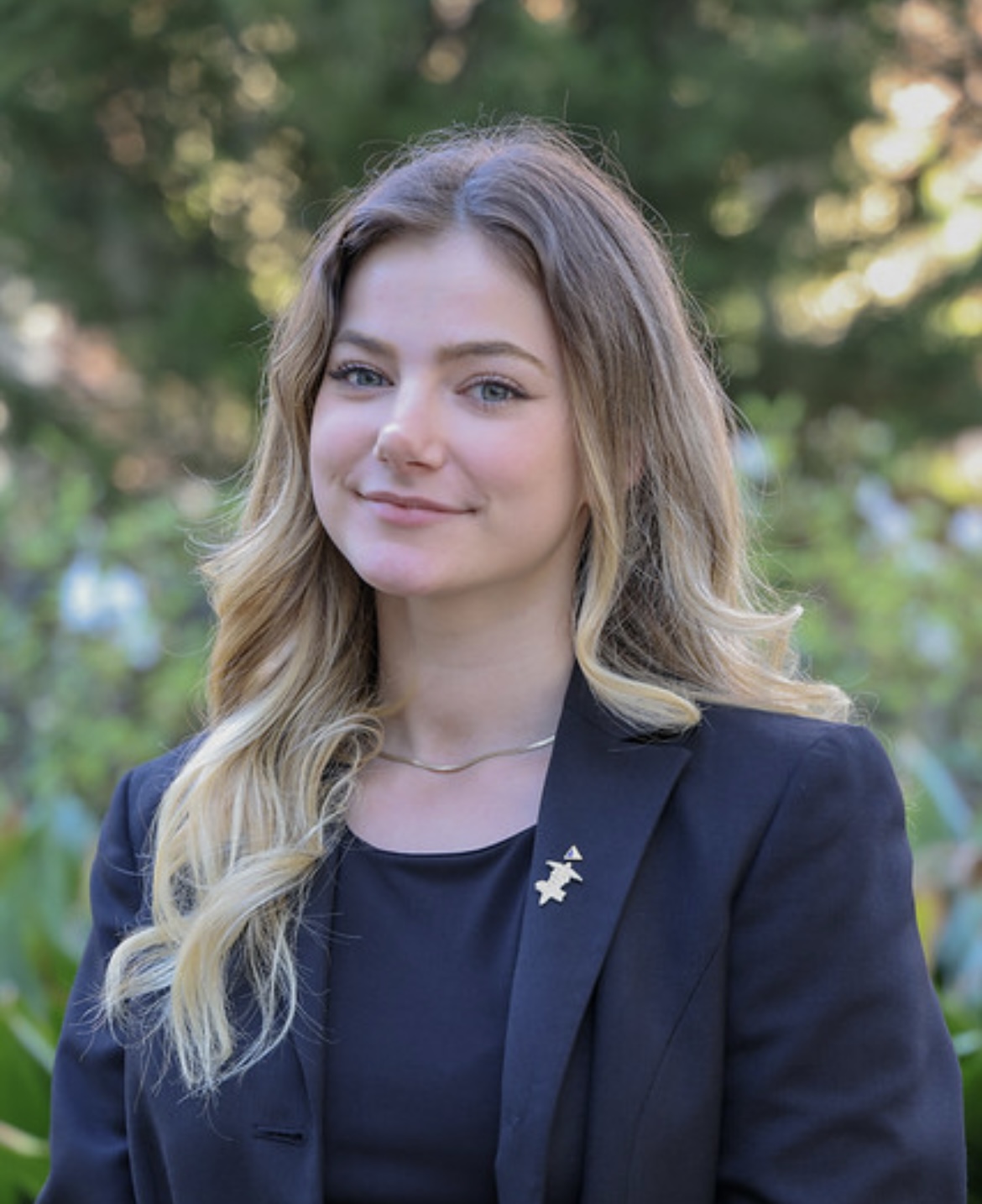
BIO
My name is Summer Chapman and I am an IMS: Clinical Professions major in my junior year. I am interested in psychological and neurological research. Currently, I am on pre-medical track with a planned gap year.
Cueing and Gait Improvement Among People With Parkinson’s Disease - A Meta Analysis
Authors: Summer Chapman, Dorota Kossowska-KuhnStudent Major: IMS: Clinical Professions
Mentor: Dorota Kossowska-Kuhn
Mentor's Department: Psychology Mentor's College: Arts and Sciences Co-Presenters: Molly Turner
Abstract
Background: Parkinson’s Disease is a neurodegenerative disease that is characterized by a loss
of movement and coordination due to an impairment of the dopaminergic nerve cells in the
substantia nigra of the basal ganglia, causing a failure to produce dopamine. Though there is no
current cure for Parkinson’s Disease, treatments using cueing to improve gait are being studied
for possible improvement of symptoms. Gait is defined as a patient’s walking patterns. Cueing is
the use of a stimulus to regulate a patient’s movement.
Methods: The aim of this project is to conduct a meta-analysis using available evidence to
examine the effects of auditory, visual, and combined auditory and visual treatments on the gait
of Parkinson’s patients. Specifically, this meta-analysis defines gait as patterns of cadence, stride
length, and velocity. A literature search was conducted using Embase, Web of Science, Medline,
CINAHL, and PubMed. Studies consisted of the application of a visual, auditory, or audiovisual
intervention treatment on patients with Parkinson’s disease, measuring changes in cadence,
velocity and stride length.
Results: The present dataset comprises 28 effect sizes from 12 studies, involving a total of 236
participants with Parkinson’s Disease. The overall findings indicate a statistically significant
difference (p = 0.05) across various aspects. As indicated by Hedge’s G, cadence (0.26), velocity
(0.26), and stride length (0.43), a small to medium effect size is observed.
Keywords: Parkinson's, Neurological, Gait
24th annual Undergraduate Research Symposium, April 3, 2024
Bryan Fortay Poster Session 5: 4:00 pm - 5:00 pm/371

BIO
Hi, my name is Bryan Fortay and I am currently a sophomore working in the Dennis lab here at FSU. I am involved with the Rugby club and love to make and play music!
My research focuses around the SWI/SNF complex and its role as a Chromatin Remodeler.
The SWI/SNF Complex and its Role as a Chromatin Remodeler
Authors: Bryan Fortay, Mahdi KhademStudent Major: Biochemistry
Mentor: Mahdi Khadem
Mentor's Department: Jonathan Dennis Lab Mentor's College: Biological Science Co-Presenters:
Abstract
This study focuses on the functional significance of the SWI/SNF chromatin remodeling complex. By utilizing a PROTAC called ACBI1, we targeted the SMARCA2 and SMARCA4 catalytic subunits of SWI/SNF for degradation via ubiquitination. We sought to identify whether treatment with ACBI1 could show a delay in the genetic markers associated with EMT. A migration assay and qPCR were utilized to measure both morphological and genetic differences when compared to a control.
We introduced ACBI1 to six wells containing our MCF10A cell line alongside a control 6 welled plate with only DMSO and MCF10A. Our wells were exposed to ACBI1 for differing amounts of time: 0,2,4,8,24, and 48 hours. A microscopy camera was used to take periodic pictures of both the PROTAC treated and DMSO controlled cells over the allotted 48-hour period. After treatment, RNA was harvested from each treatment group and a qPCR, or real time PCR, was conducted to measure the presence of markers associated with EMT. These markers being: SNAI2, Fibronectin, E-Cadherin, N-cadherin, GAPDH, and Vimentin.
We witnessed a lack of migration in the cells treated with the ACBI1 PROTAC whilst our DMSO control cells migrated normally. Additionally, our qPCR showed an increase in the CT values for our ACBI1 treated cells compared to our control.
These results hold implications for the function of SWI/SNF in TGF-BETA induced EMT. Increased CT values show a delay of expression. Future studies should be directed at finding the direct function of SMARCA2 and SMARCA4 in tumor metastasis.
Keywords: Biology, SWI/SNF, EMT
24th annual Undergraduate Research Symposium, April 3, 2024
Indira Columbie Poster Session 2: 10:45 am - 11:45 am/28
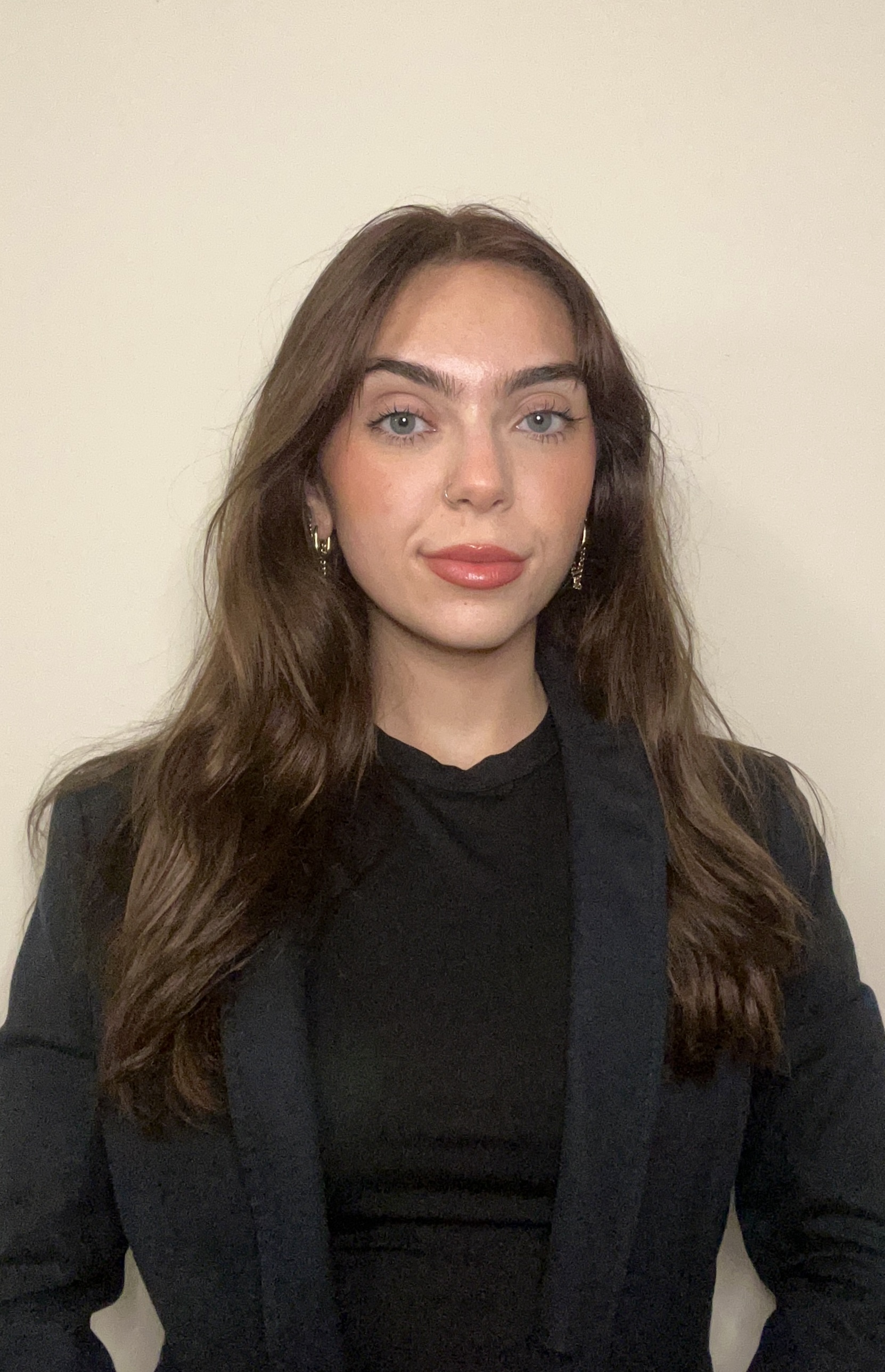
BIO
I am a senior doing an undergrad-grad program. My goal is to acquire my master's in Spring 2025 after graduating with my bachelor's in Summer 2024. My interests in criminology is the psychological background of crime and offending, as well of the role that motives and behaviors play in distinguishing offender from offender. I am also interested in the role biosocial criminology plays into all of this. I have recently gained a new in hate crime due to taking Dr. Lantz's, my mentor on this research, graduate hate crimes seminar course. I decided to conduct my research on a pressing topic in hate crime literature.
Protecting Gender: State Variation in the Inclusion of Gender in Hate Crime Legislation
Authors: Indira Columbie, Brendan LantzStudent Major: Criminology
Mentor: Brendan Lantz
Mentor's Department: Criminology Mentor's College: College of Criminology and Criminal Justice Co-Presenters:
Abstract
Hate crimes occur globally and there is substantial variation in the responses law enforcement, government, and communities have towards this phenomenon. The majority of the United States has made efforts towards eradicating prejudices that manifest into hate crimes by passing legislation. Many states protect characteristic criterion of potential hate crime victims such as race, but the focus of this research lays in inclusion of gender. While 31 of 50 states include gender as a protected category for hate crimes, many states do not. This omission has serious implications, including the negative effects it has on victims and society as a whole. In this research, the differing responses to female victims of crime will be explored in states which protect gender under hate crime legislation, relative to those that do not. Execution of law enforcement procedures after the occurrence of a crime with female victims will be analyzed in both categories of states. The responses of victims to their own victimization will also be explored. This will be accomplished by performing a comparison between a case of a female hate crime victim in a state that includes gender and a case in a state in which gender is not included. The purpose of this research is to gather information on how including gender in hate crime policy can affect they ways in which victims and law enforcement respond to gender-motivated hate crime. These implications will then serve as a proxy to highlight the importance and necessity of all states protecting gender.
Keywords: hate crime, gender, florida
24th annual Undergraduate Research Symposium, April 3, 2024
Rordan Mullen Poster Session 3: 1:30 pm - 2:30 pm /379

BIO
I am originally from Weston, FL and currently studying Biological Sciences at Florida State University on a pre-medical track.
PLWH and LGBT Elder Abuse: A Systematic Review
Authors: Rordan Mullen, Dr. Casey Xavier HallStudent Major: Biological Sciences
Mentor: Dr. Casey Xavier Hall
Mentor's Department: Nursing Mentor's College: College of Nursing Co-Presenters:
Abstract
BACKGROUND: Members of the LGBTQ+ community are susceptible to multiple forms of
stigma and violence, namely homophobia, discrimination on the basis of sexual orientation, hate
crimes and domestic violence. People living with HIV/Aids (PLWH) are subjected to similar
expressions of prejudice due to the lingering stigma and lack of education regarding the disease,
almost half a century after the AIDS epidemic began to grip the United States. However, a
commonly overlooked intersection of these two groups is the hate and abuse specifically targeted
towards LGBTQ+ people or PLWH who are older than middle-aged. Little research has been
focused on the impact that being an older PLWH or LGBTQ+ member has on the likelihood of
experiencing violence and discrimination.
GOALS: This study is a systematic review that seeks to analyze existing literature written on
this topic, aiming to understand the prevalence of stigma and violence affecting these groups.
The platform Covidence was used to analyze the abstracts of over 10,000 research articles, in
order to select those meeting the proper criteria to then be reviewed (original work, LGBTQ+ or
PLWH subjects over the age of 50, mentions of violence including discrimination and physical
abuse). The articles that met this criteria then will have their full texts reviewed in order to have
both qualitative and quantitative data extracted. This project is ongoing.
Keywords: systematic review, discrimination, stigma
24th annual Undergraduate Research Symposium, April 3, 2024
Sofia Andrade Poster Session 5: 4:00 pm - 5:00 pm/438

BIO
I am a first year biological science student on the premed track with a special interest in microbiology and immunology. I am part of the Latino community and I am from Miami, Florida. My career goals include completing medical school and an internal medicine residency to hopefully get the chance to improve quality of life and public health.
Phylogenetic Analysis of AP Complexes
Authors: Sofia Andrade, Qian YinStudent Major: Biological Science
Mentor: Qian Yin
Mentor's Department: Molecular Biophysics Mentor's College: College of Arts and Sciences Co-Presenters: Julia Denis, Roberto Gomez, Laura Dong
Abstract
Eukaryotic organisms possess compartmentalized, membrane-bound organelles. To transport cargo between and into these compartments, there must be a highly regulated system of proteins that control vesicle formation and movement. Adaptor proteins (APs) function to mediate endocytosis by preparing a clathrin-coated vesicle, which is essential for interaction with the environment and is commonly manipulated by viruses. Many organisms across the eukaryotic phyla share various types of APs. This project analyzes the evolution of AP-1 and AP-2 by constructing phylogenetic trees of each of the four subunits across one hundred different species. Similar research has been done on this subject; however, such work had often studied a larger range of proteins over a smaller range of species. This study will help elucidate the specific conserved genes and mechanisms between species as they evolved over time. These sequences were downloaded and processed through a phylogenetic software program created by the National Institutes of Health. The results are related to similar onsets of AP subunits between species, reflecting a similar common ancestor. By understanding the evolution of APs 1 and 2, and their associated assembly proteins, similar methods could be applied to other members of the AP family, including those which have just been discovered. This leaves a promising future for AP discovery and comparison, as well as further insight into the methodology of uncovering mechanisms of cell survival and disease prevention.
Keywords: AP Complexes Immunology
24th annual Undergraduate Research Symposium, April 3, 2024
Sophia Turnage Poster Session 5: 4:00 pm - 5:00 pm/23
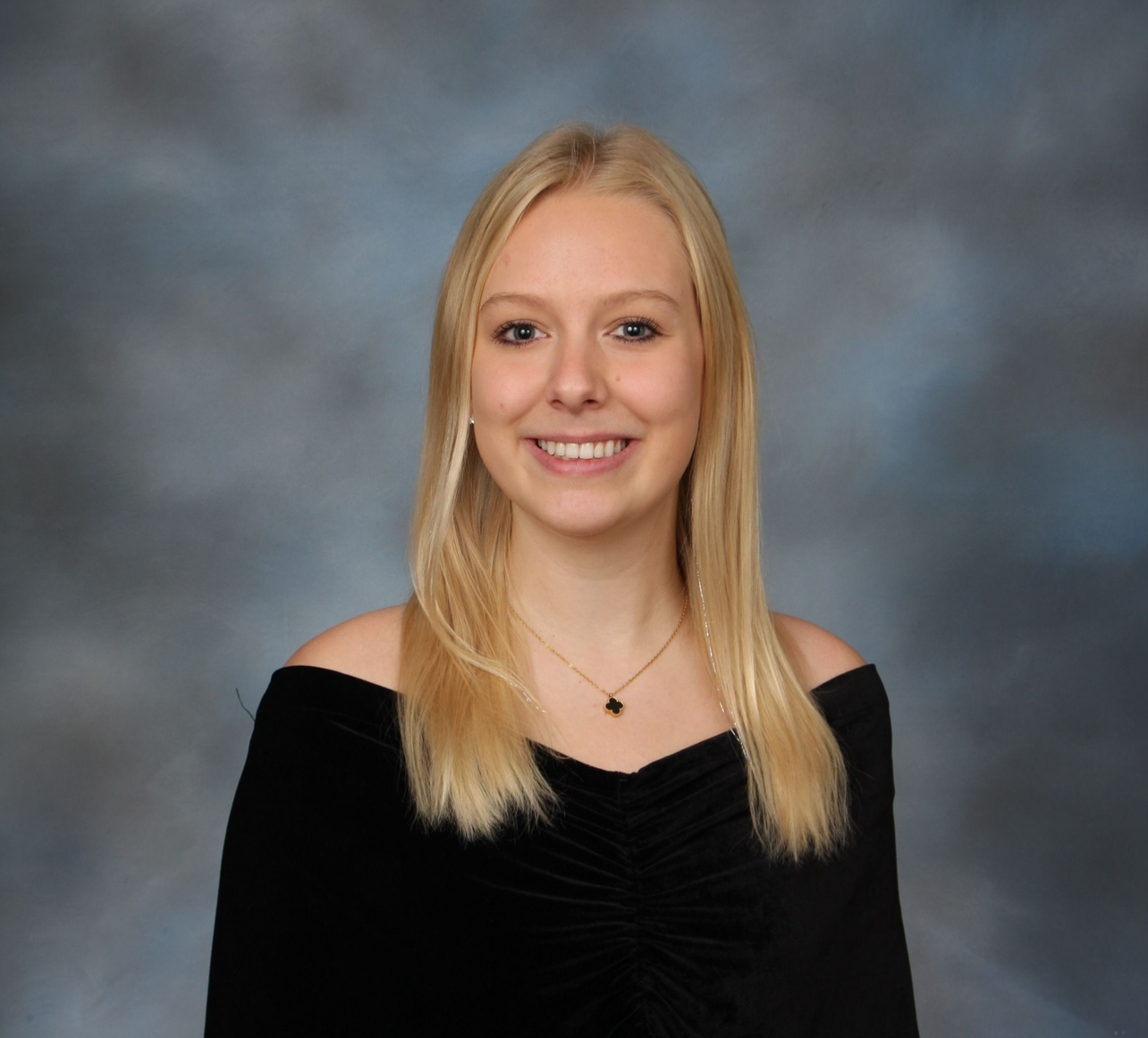
BIO
My name is Sophie and I'm from Yorktown, Virginia. I am majoring in Biological Science with a minor in Computer Science. I am a member of Phi Mu where I hold a chair position and a new member of a pre-medical fraternity, Phi Delta Epsilon. I enjoy going on road trips, traveling overseas, and spending time with my family, friends, and dogs. I have always had an interest in science, and more specifically in medicine. I am currently an ER scribe for a Level 2 Trauma Center at Tallahassee Memorial Hospital. After college, I plan to attend medical school and become a surgeon. I am very passionate about my my work and enjoy learning from mentors and professors here at FSU.
Rates of Crassostrea virginica metamorphosis and fatality due to varying concentrations of epinephrine
Authors: Sophia Turnage, Emily Fuqua, PhD CandidateStudent Major: Biological Science
Mentor: Emily Fuqua, PhD Candidate
Mentor's Department: Biological Science Mentor's College: Coastal and Marine Laboratory Co-Presenters:
Abstract
In the Gulf of Mexico, the population size of Eastern oysters, Crassostrea virginica, has declined rapidly with a loss of approximately 85% of the original population. Oyster populations have struggled to rebound or level out due to pollution, changing water conditions, and loss of habitat. Scientists have searched for methods to increase oyster populations, but one of the largest barriers to success is the extremely low rate of survival to adulthood. By creating a method to help accelerate oysters into metamorphosizing, it is possible to contribute to efforts to increase oyster populations in the Gulf of Mexico. So, we tested the use of epinephrine in the acceleration of metamorphosis in oyster larvae as they were exposed to varying concentrations of an epinephrine solution. The oysters’ metamorphosis and mortality rates were tracked for each concentration. Oysters exposed to lower levels of epinephrine had the most survive but the least metamorphosize, however higher levels had extremely high mortality rates. There was an optimal concentration that maximized metamorphosis before mortality rates increased significantly. The epinephrine introduction appeared to have positive effects on metamorphosis, but negatively impacts survival when the concentration reached a certain threshold.
Keywords: Metamorphosis, Oyster, Epinephrine
24th annual Undergraduate Research Symposium, April 3, 2024
Judah Alter Poster Session 4: 2:45 pm - 3:45 pm /280

BIO
My name is Judah Alter, I am a current Sophomore at FSU and have a passion for computer science. I hope to get into front end applications and help create and update systems to perform better and create platforms with remarkable UI features. I also love to dive deep into machine learning and AI and hope to use technology to better the world. Outside of school, i am involved on campus through charity and greek life participation.
Understanding EV Adoption and Charging Infrastructure Accessibility in Florida
Authors: Judah Alter, Guang WangStudent Major: Computer Science B.S.
Mentor: Guang Wang
Mentor's Department: College of Art and Sciences Mentor's College: Massachusetts Institute of Technology Co-Presenters: n/a
Abstract
Electric Vehicles (EVs) is becoming an ever-growing industry and leaning towards replacement to the former household gas powered vehicle. With rising fuel prices around the country, consumers are choosing to go green and adopt an environmentally friendly option of purchasing an EV .Using multiple outlets of resources, we recorded and analyzed data on the number of registered EVs and number of charging stations located throughout Florida. Through our analysis we then searched by
county, the number of registered EVs and the number of charging stations. With this data we then begin to understand the disparity between charging station numbers in comparison to registered EVs. The data can help set the structure for
creating a plan of introduction to either EVs or charging stations that consumers, businesses, and local governments can all
use.
Keywords: EV Accessibility
24th annual Undergraduate Research Symposium, April 3, 2024
Matthew Hutchins Poster Session 1: 9:30 am - 10:30 am /216
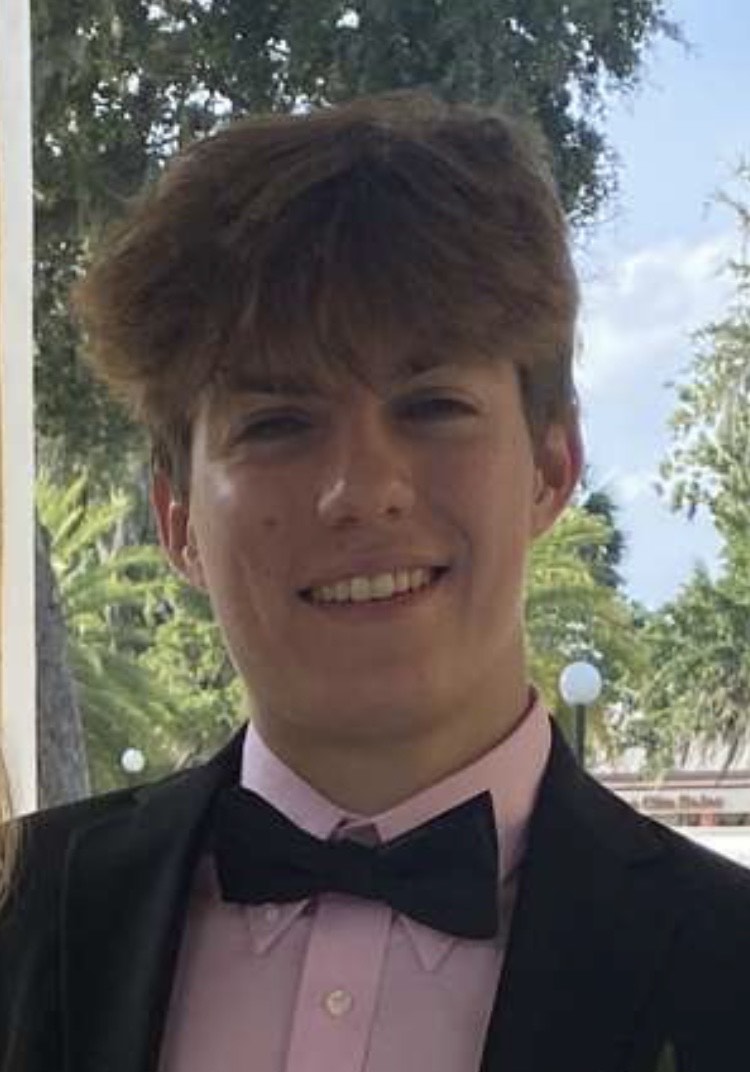
BIO
My name is Matthew Hutchins, I am originally from Titusville, Florida. Currently I serve as a researcher here at FSU with a passion for cell and tissue engineering. I'm constantly drawn to the forefront of scientific innovation, eager to channel my expertise into the pharmaceutical industry and revolutionize human medicine. My commitment to advancing biotechnological solutions reflects my ambition to leave a lasting impact on global health.
Developing An AI-based Particle-tracking Algorithm For Cardiac Muscle Cell Growth and Contractility
Authors: Matthew Hutchins, Dr. Christopher SolisStudent Major: Biomedical Engineering
Mentor: Dr. Christopher Solis
Mentor's Department: College of Education, Health, and Human Sciences Mentor's College: Health and Human Sciences Co-Presenters: Hannah Maken, Rick Geneus
Abstract
Our goal is to evaluate images showing the assembly and disassembly processes, which will be important examples for constructing an algorithm to estimate sarcomere growth within cardiac muscle cells. Reaching this objective will make a substantial contribution to our knowledge of the dynamics of the heart muscle and may also yield new perspectives on exercise physiology and heart health. The study of sarcomere growth in real time may yield important insights into the heart's response to different stimuli, which could guide the creation of effective treatments for cardiovascular disorders. Furthermore, this approach might be used more broadly to investigate the cellular dynamics of other muscle tissues, which would promote tissue engineering and regenerative medicine. This multidisciplinary approach has the potential to spur innovation and advancement in the field of biomedical research and lead to groundbreaking discoveries. The expansion of each individual cardiac muscle cell propels the heart's growth in response to exercise. Sarcomere construction, the cytoskeletal framework seen in muscle cells, facilitates this expansion. Our team has the ability to stimulate cells to work harder in a lab setting, which causes the cells to spontaneously boost the creation of sarcomeres. A crucial protein found in sarcomeres, alpha-actinin acts as a structural element that makes it easier for other proteins, such as actin, to be anchored. In a recent paper, we demonstrated the ability of two medications to control sarcomere construction and disassembly. So far, we've used specialized dyes to visualize sarcomeres and immobilized heart muscle cells to track this progress.
Keywords: Sacromere, AI, Cells, Matlab, Heart
24th annual Undergraduate Research Symposium, April 3, 2024
Matthew Parkis Poster Session 3: 1:30 pm - 2:30 pm/120
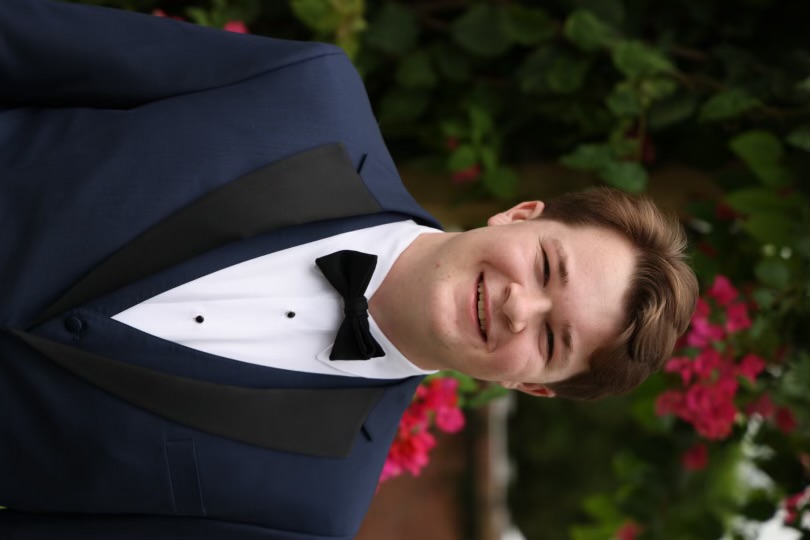
BIO
Hi, my name is Matthew Parkis and I am from winter Park, Florida. I am currently a pre-med student here at Florida State majoring in IMS: Clinical Professions. After completing my undergraduate degree, I hope to attend medical school and specialize in dermatology, sports medicine, or aerospace medicine! Along with being interested in housing I am also passionate about student advocacy within housing here at FSU. As the current president of my dorm hall council as well as a resident assistant for the 2024-2025 academic year. Coming into FSU I knew I was interested in doing research and am fortunate enough to have had the opportunity to do so with the guidance of Dr. Meredith McQuerry. The research project I worked on for UROP, focused on the evaluation of the performance of warfighter personal protective equipment in Subartic conditions. This is important to me as it helps me not only develop my research and professional skills but also helps me get involved into a field of study I wish to pursue later on in life. I cannot thank Dr. McQuerry and the entire ThermaNOLE Comfort Lab team enough for providing me this opportunity here at Florida State!
Heated Garments for Warfighter Operations in Subarctic Conditions
Authors: Matthew Parkis, Dr. Meredith McQuerryStudent Major: Interdisciplinary Medical Sciences: Clinical Professions
Mentor: Dr. Meredith McQuerry
Mentor's Department: Textile Testing & Performance Measurement Mentor's College: Jim Moran College of Entrepreneurship Co-Presenters: Lily Dennis
Abstract
Warfighters are often required to endure extreme cold temperatures, regularly reaching -60˚C. These conditions can be strenuous, if not dangerous, to the body and can impact performance. Adequate protection in subzero conditions is often achieved via multiple fabric and garment layers, however, the mobility of the wearer is often negatively impacted. This makes it more difficult for warfighters to make precise motions during combat, especially concerning extremities like finger dexterity, which is vital for pilots or other personnel that require delicate and precise movements. Therefore, the purpose of this research was to determine the ability of a proprietary heated base layer system to maintain thermal insulation when wearing cold weather warfighter ensembles in subzero conditions (0 ˚C, -10˚C, -20˚C). Three warfighter combat uniforms (light, intermediate, and cold) were assessed utilizing an ANDI dynamic sweating thermal manikin, in the ThermaNOLE Comfort Lab® at Florida State University to measure thermal insulation. Each uniform was assessed in conjunction with a proprietary heated base layer system at three temperatures and four power levels (no heat, low, medium, and high) to determine the efficacy of maintaining thermoregulation without excessive clothing bulk. Results indicate the heated base layer maintained and, in some cases, significantly increased, the thermal insulation and surface temperature of the manikin, especially in the lower temperature conditions (0 ˚C and -10 ˚C). At -20 ˚C, temperatures were significantly enhanced at the medium and high-power levels. Future research should investigate how to hone each power level as to maintain the thermal insulation the best.
Keywords: Warfighter operations, Subarctic, equipment
24th annual Undergraduate Research Symposium, April 3, 2024
Brentley Durham Poster Session 2: 10:45 am - 11:45 am/436
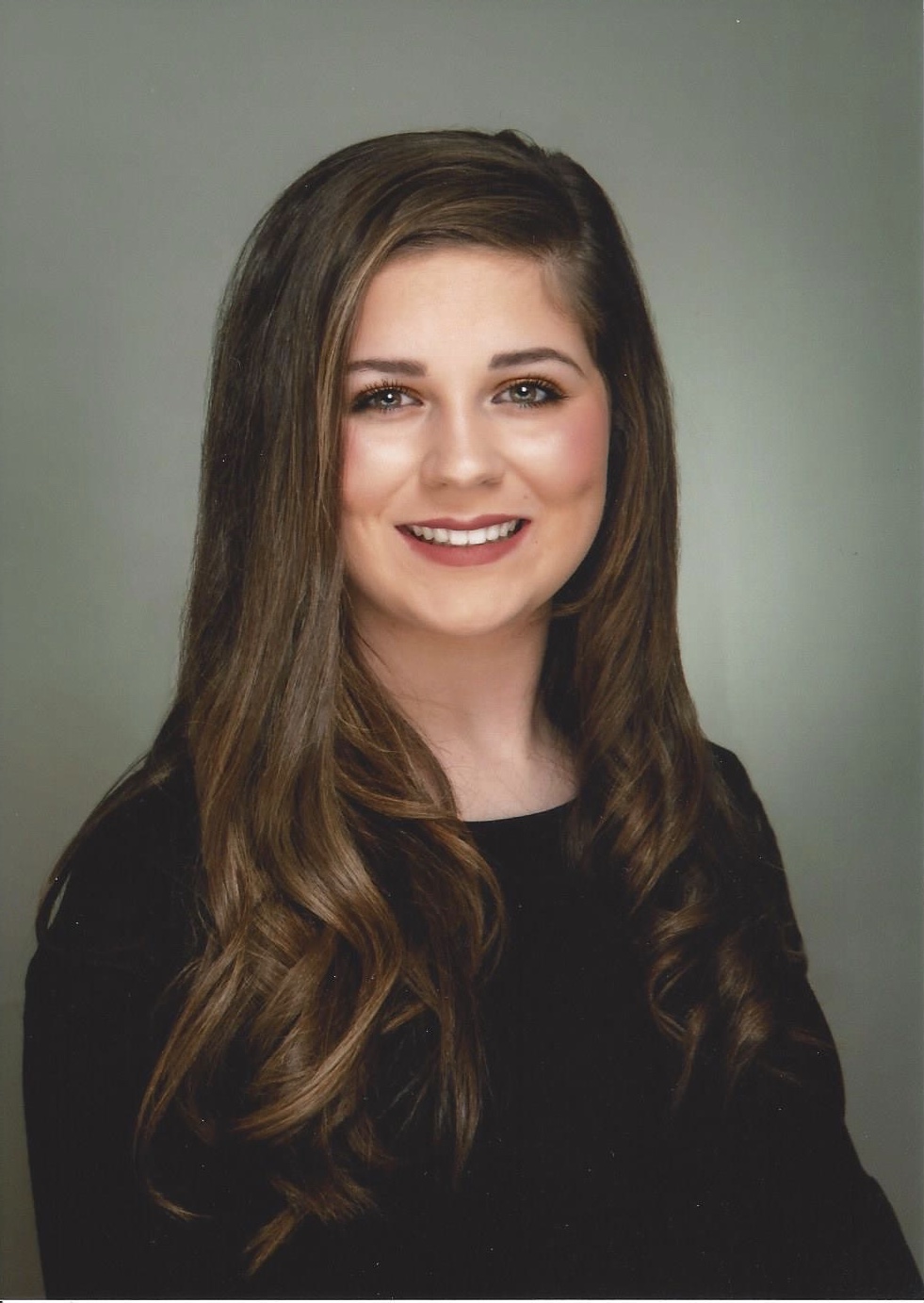
BIO
While majoring in Biological Sciences, I have placed emphasis on marine biology. I hope to pursue graduate school before working in marine research. I am originally from Cartersville, Georgia but hope to spend much of my career traveling to various marine environments across the globe.
Photogrammetric Modeling of Artificial Reefs to Measure Reef Accretion
Authors: Brentley Durham, Shannon MurphyStudent Major: Biological Sciences
Mentor: Shannon Murphy
Mentor's Department: Biology Mentor's College: Arts and Sciences Co-Presenters: Iliza Aguiar
Abstract
Oysters are a foundation species in Apalachicola Bay and they provide many ecological and ecosystem services to this productive and valuable ecosystem, including habitat for an array of commercially and ecologically important species. The oyster fishery in Apalachicola Bay collapsed in 2013 and oysters have continued to decline despite significant restoration efforts. Restoring the lost ecosystem services in Apalachicola Bay will require understanding the recovery potential of the historical reef sites and ensuring that they are responding to restoration efforts. The goals of this research are to provide insight into how quickly oysters and other reef species recruit and grow on artificial complex habitats. Artificial reef structures were deployed at sites across the bay spanning a gradient of environmental conditions. These structures are being surveyed for recruitment and calculations of total volume every 6 months using photogrammetric techniques, for 2 years (ending in April 2024) to quantify accretion rates at each site. Data will be analyzed to understand how environmental conditions influence the colonization and growth of oysters and other benthic fauna across the bay. These data will help understand how environmental characteristics influence recovery of oyster reef associated communities and identify the most promising sites for successful future restoration efforts
Keywords: marine, photogrammetric modeling, restoration
24th annual Undergraduate Research Symposium, April 3, 2024
Emma Tripp Poster Session 1: 9:30 am - 10:30 am /103
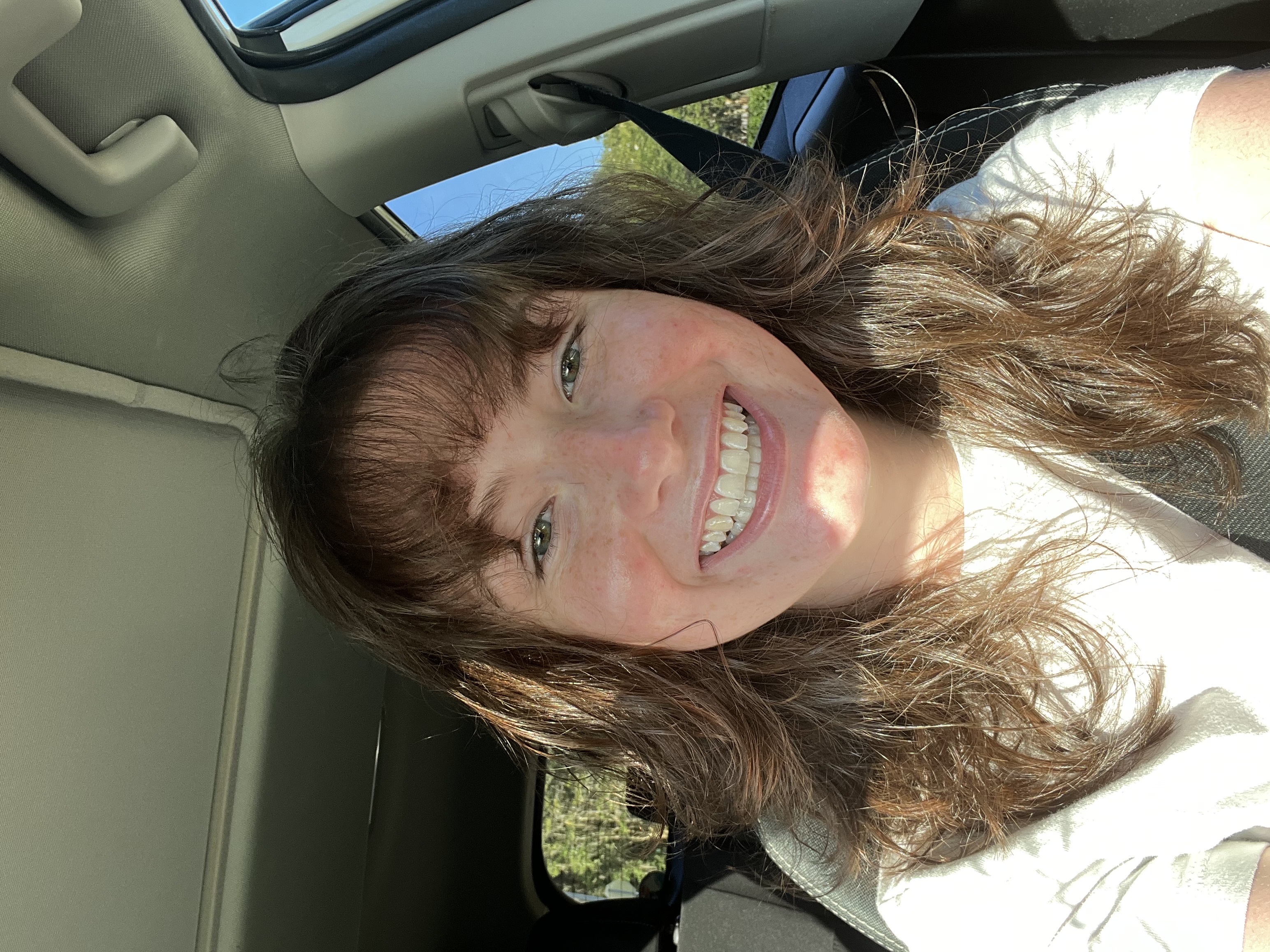
BIO
Emma Tripp is a third year behavioral neuroscience student at Florida State University. She joined the Martin Lab in the summer of 2023 and has been working closely with a grad student on research since. She plans to go to medical school after her undergraduate degree and continue research throughout her career.
Neural Basis of Face Recognition in Older Adults
Authors: Emma Tripp, Chris MartinStudent Major: Behavioral Neuroscience
Mentor: Chris Martin
Mentor's Department: Neuroscience Mentor's College: Arts and Sciences Co-Presenters:
Abstract
The ability to recognize a personally familiar face, such as a loved one, is a cognitive function used in everyday life. However, adults diagnosed with Alzheimer’s disease (AD) experience an impairment of this ability, which contributes to the negative impact AD has on quality of life. We used functional magnetic resonance imaging (fMRI) to characterize differences in neural activity related to face recognition in older adults with and without indications of mild cognitive impairment (MCI). Specifically, we examined differences in brain activity evoked by recognition of personally familiar (PF), experimentally familiar (EF), and novel (i.e., a stranger) faces. EF faces were learned in a series of lab-based encoding tasks. All participants were asked to discriminate between the three categories of faces (PF, EF, and novel) during functional neuroimaging. We hypothesized discernible differences in neural activity between the healthy and MCI adults for different face categories. Results revealed a differentiation for PF and EF faces in the medial parietal and medial temporal areas of the default mode network (DMN). This finding is aligned with the role of DMN in self-referential processing and the cognitive processes involved in person identity recognition. Further analyses will use a pattern-based similarity analysis to quantify representational change among recognition signals for the different faces. We anticipate that recognition in cognitively healthy older adults will be characterized by signals that reliably differentiates between face categories, whereas people with MCI will show a restricted representational space such that faces from all categories evoke similar activity patterns.
Keywords: face recognition, AD, older adults, memory
24th annual Undergraduate Research Symposium, April 3, 2024
Timothy Barbara Poster Session 4: 2:45 pm - 3:45 pm /168

BIO
B.S. of Psychology student from Tampa, Florida.
Influence of Familiarization With Immersive Virtual Reality on Presence Over Time: A Pilot Study
Authors: Timothy Barbara, Dorota Kossowska-KuhnStudent Major: Psychology
Mentor: Dorota Kossowska-Kuhn
Mentor's Department: Psychology Mentor's College: College of Arts and Sciences Co-Presenters: Eden Cisneros and Ryan Wasserman
Abstract
Abstract
Background: The effectiveness of Immersive Virtual Reality (IVR) across various domains such as medical interventions (Carl et al., 2018), social psychology (Barreda-Angeles & Hartmann, 2022) and cognitive training (Cohavi & Levy-Tzedek, 2022; Wais et al., 2021) is well-documented. Presence, or the "sense of being there," is a crucial element in the effectiveness of IVR (Weech et al., 2019; Gibbs et al., 2022). While IVR has been suggested to be a successful tool across a variety of domains, it may be that presence enables these outcomes. This study aims to explore how presence in IVR and degree of mood change are affected by repeated exposure.
Methods: We intend to investigate how presence may change over time during an IVR-based study, as well as how the degree of mood change, a commonly recorded behavioral factor in IVR paradigms, may be affected by familiarization. The study will involve cognitively healthy adults aged 65 and older, who will participate in leisure-based IVR experiences, engaging in 5 to 15 sessions, each lasting 30 minutes.
Results: We hypothesize that presence will decrease across repeat sessions.
Conclusion: The findings of this study will provide insights into the dynamics of presence in IVR and its psychological impacts over time.
Keywords: Presence, Virtual Reality, Familiarization
24th annual Undergraduate Research Symposium, April 3, 2024
Lauren Blackwell Poster Session 2: 10:45 am - 11:45 am/432

BIO
My name is Lauren, I am currently a Senior from Miami, Florida. I am in the honors program and I am currently on a pre-PA track. I am interested in Cardiac Health and currently work as a Hemostasis Technician in the Cath lab at Tallahassee Memorial hospital.
The application of 3-D printing anatomical structures
Authors: Lauren Blackwell, P. Bryant ChaseStudent Major: Biological Science
Mentor: P. Bryant Chase
Mentor's Department: Biological sciences Mentor's College: The University of Washington Co-Presenters: Alexandra Martin, Ryan Schroy, Michelle Rodriguez
Abstract
3D printing is a form of manufacturing physical object from a three-dimensional digital model. ChimeraX is a software used to manipulate and analyze atomic structures and their molecular components. ChimeraX was used to modify 7KO4, a structure of cardiac native thin filament, and other high-resolution structures such as 8UWW (troponin), to prepare for 3D printing. Through the EMDB website, these structures were downloaded, modified, and through trial and many stl files later successfully printed. For the purpose of building a structure that can be separated and differentiated, ChimeraX will be used to color the different components of a muscle cell (actin, tropomyosin, and troponin). These components can then be magnetized with the aim of reassembly to understand how their processes work together. When 7KO4 was printed, it was used as a model to clarify findings in muscle mechanic laboratories among researchers in the Biology Department. We hope to bring awareness to the benefits of visual model usage in educational settings as well as for future research purposes through the use of 3D printing and ChimeraX. This project demonstrates the importance of a cellular structure that is normally understood in its photographed two-dimensional state. Outside of the educational sphere, 3D models can aid in the identification of missing components or contribute towards higher understandings of the molecular structures. These prints can be modified and added to as new research develops and ideas are discovered.
Keywords: Troponin, muscle motility, 3D printing
24th annual Undergraduate Research Symposium, April 3, 2024
Sophia Gannaoui Poster Session 5: 4:00 pm - 5:00 pm/161
BIO
Sophia Gannaoui is a 4th year Choral Music Education major from Kissimmee, Florida. Her research interests include music, linguistics, and ethnomusicology. She is currently involved with the CRE serving as a UROP Leader and UROP Leader Mentor. After graduation, she plans on becoming a choral director and utilizing her Instagram, @isntshesosharp, to make access to research easier for people to be exposed to through social media.
Exploring Diversity in Religious Repertoire Through Choral Music
Authors: Sophia Gannaoui, Dr. Kevin FentonStudent Major: Choral Music Education
Mentor: Dr. Kevin Fenton
Mentor's Department: Music Education Mentor's College: College of Music Co-Presenters:
Abstract
With the intention of supporting the American Choral Directors Association's vision for creating "powerful artistic experiences and [advocating] for cultural and educational change" to transform the lives of students, this project aims to bring exposure to diverse religious repertoire in choral music that enhances the cultural and educational experiences of students within the choral classroom, in addition to bringing forth representation for students that are followers of the religions that are exposed. This project specified criteria for what qualifies choral literature to be "diverse," providing choral directors the opportunity to discover diverse religious choral works outside of the recommendations this project offers. Examining existing works within the big three Abrahamic religions of Christianity, Judaism, and Islam- there is a lack of representation in choral music for Muslim populations. This is due to Islam having stricter regulations on music, and choral music typically referring to notated group singing which is common practice in the Western world. With the criteria offered to identify diversity in religious repertoire and providing examples of music that fit these criterion, this project supports and aims to inspire the creation of more choral music that represents underrepresented religions in the choral world in a respectful manner.
Keywords: music, religion, diversity
24th annual Undergraduate Research Symposium, April 3, 2024
Julia Dennis Poster Session 4: 2:45 pm - 3:45 pm /438
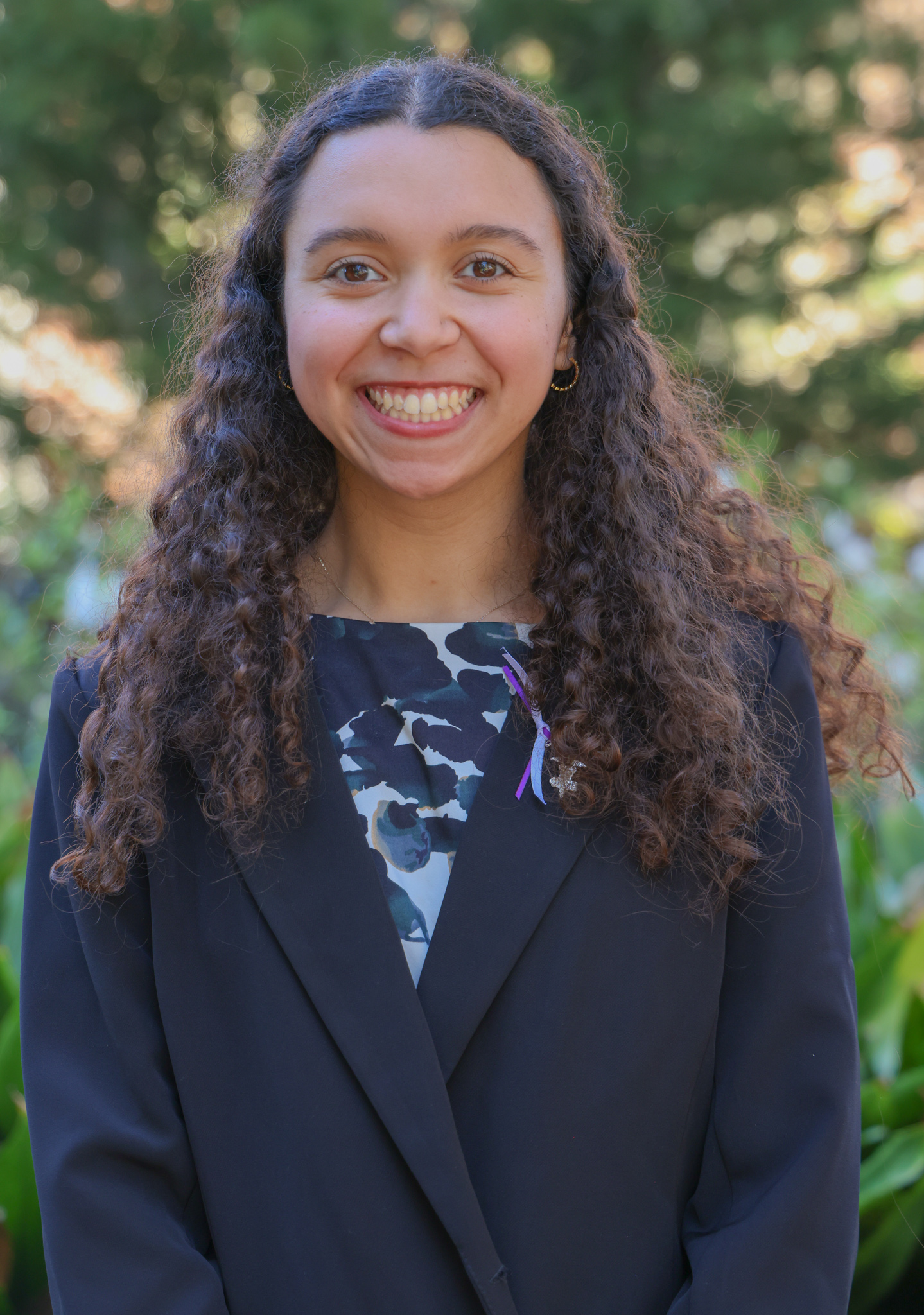
BIO
I am a third year senior from Orlando, FL. As a pre-medical student, I am passionate about evidence-based medicine and patient-centered care. Apart from this project, I am very interested in studying how infections and inflammation can influence preterm birth and neonatal outcomes.
Evolutionary Insights: Phylogenetic Analysis of AP-1 and AP-2 and their Assembly Mechanisms in Eukaryotes
Authors: Julia Dennis, Qian YinStudent Major: Biological Sciences and Public Health/Pre-medical track
Mentor: Qian Yin
Mentor's Department: Molecular Biology Mentor's College: Arts and Sciences Co-Presenters: Sofia Andrade, Roberto Gomez, Laura Dong
Abstract
In order to traffic proteins and other cellular cargo, a packaging system must be assembled to do so. Adaptor proteins (APs) function to mediate endocytosis by preparing a clathrin-coated vesicle, which is essential for cellular interaction with its environment and is manipulated in common mechanisms of viral infection. Many organisms across the various eukaryotic phyla share various types of APs. This project is analyzing the evolution of AP-1 and AP-2 by constructing phylogenetic trees of each of the four subunits across one hundred different species. Similar work has been done on this subject, however, such work often studied a larger range of proteins over a smaller range of species. This study will help elucidate the various conserved genes and mechanisms between species as they evolved over time. Various proteomic databases were consulted, including but not limited to UniProt and BLAST. These sequences were downloaded and processed through a phylogenetic software program created by the National Institutes of Health. The results are related to similar onsets of AP subunits between similar species, reflecting a similar common ancestor. By elucidating the evolution of APs 1 and 2, and their associated assembly proteins, similar methods could be applied to other members of the AP family, including those which have just been discovered. This leaves a promising future for AP discovery and comparison, as well as another insight into the methodology of uncovering mechanisms of cell survival and disease prevention.
Keywords: Evolution, Phylogenetic Analysis
24th annual Undergraduate Research Symposium, April 3, 2024
Michael Moreo Poster Session 2: 10:45 am - 11:45 am/246
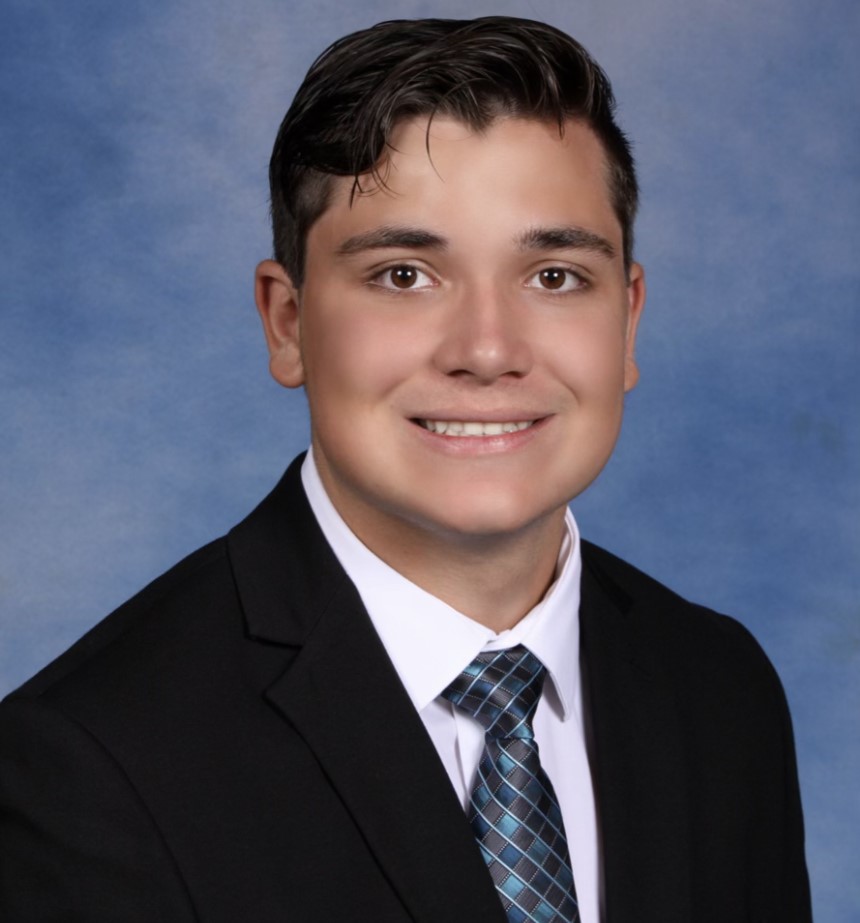
BIO
I am Michael Moreo and I am studying Environmental Science here at Florida State. My field is jam-packed with research opportunities, and there was no better way to develop the framework of my career than to work on a project through UROP. What draws me to this type of research is the ability to look at certain concepts and ideas like a blueprint, to develop a hypothesis for it, and to watch our "machine" run through trials. I plan to take what I've learned through UROP and apply for an IDEA Grant before graduation, as well as further my education through grad school.
Investigating the Influence of Comprehension Questions on Readers’ Gaze in Graphic Narratives
Authors: Michael Moreo, Aaron RodriguezStudent Major: Environmental Science
Mentor: Aaron Rodriguez
Mentor's Department: English Mentor's College: Arts and Sciences Co-Presenters: Kayla Potts
Abstract
With the increasing prevalence of multimedia content in digital environments, understanding how individuals allocate visual attention to various elements becomes crucial for content creators and designers. This study employs eye-tracking technology to investigate visual attention patterns in response to multimedia stimuli, aiming to unravel the factors influencing gaze behavior. Participants were exposed to a diverse set of multimedia content, including comics in particular, while their eye movements were to be tracked using state-of-the-art eye-tracking equipment. The study incorporates a diverse participant pool to ensure a broad representation of demographic factors. Data analysis involved the examination of fixation durations, saccade patterns, and the identification of regions of interest within the stimuli. We conducted the actual study in February, and expect to find results that align with previous works with eye tracking in comic book reading. Typically, the average reader, especially one who has never picked up a comic book, will jump from the book at the top left of the page to what seems to be the biggest box, or the box with the most eye-popping action, even if it is not the next in chronological order. For our study, since our pool of participants will be random and assorted from various backgrounds, we expect most readers to follow the typical trend seen within paralleled studies. This eye-tracking study provides valuable insights into the ways individuals navigate and engage with multimedia content. Understanding these visual attention patterns can inform educators about optimizing their materials to capture and retain audience attention.
Keywords: eye-tracking, educators, comic books, heat maps


